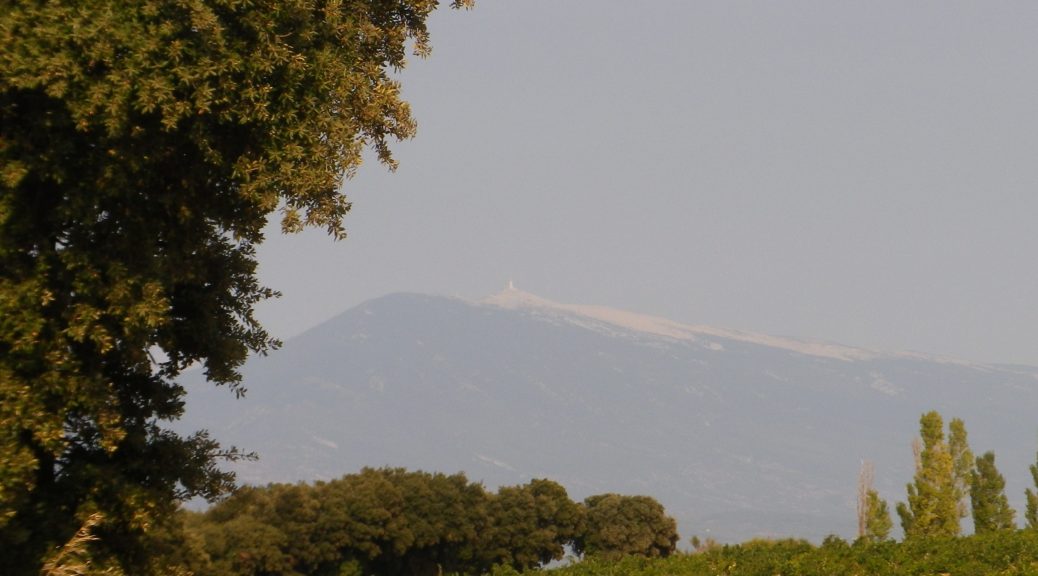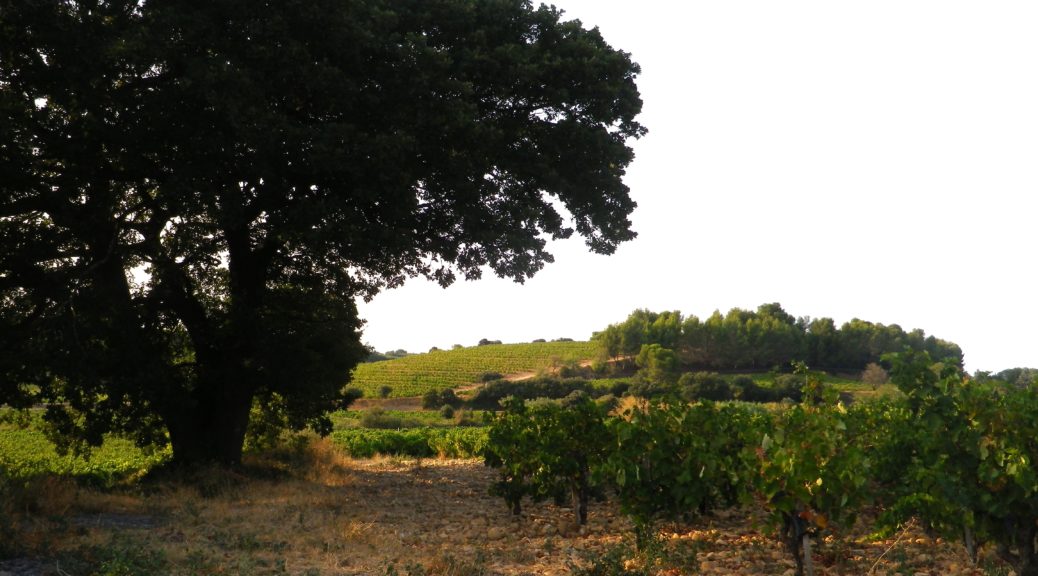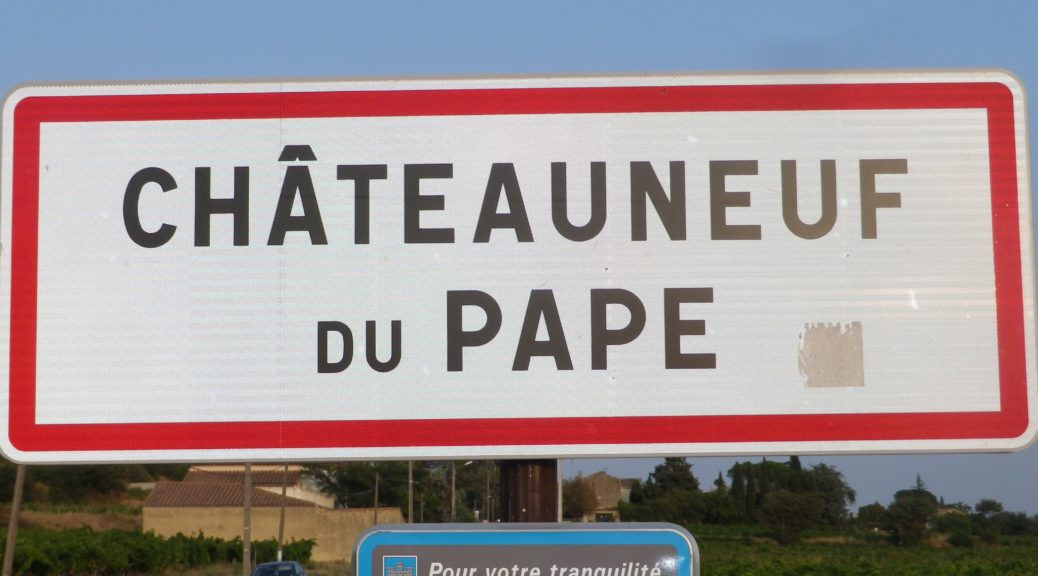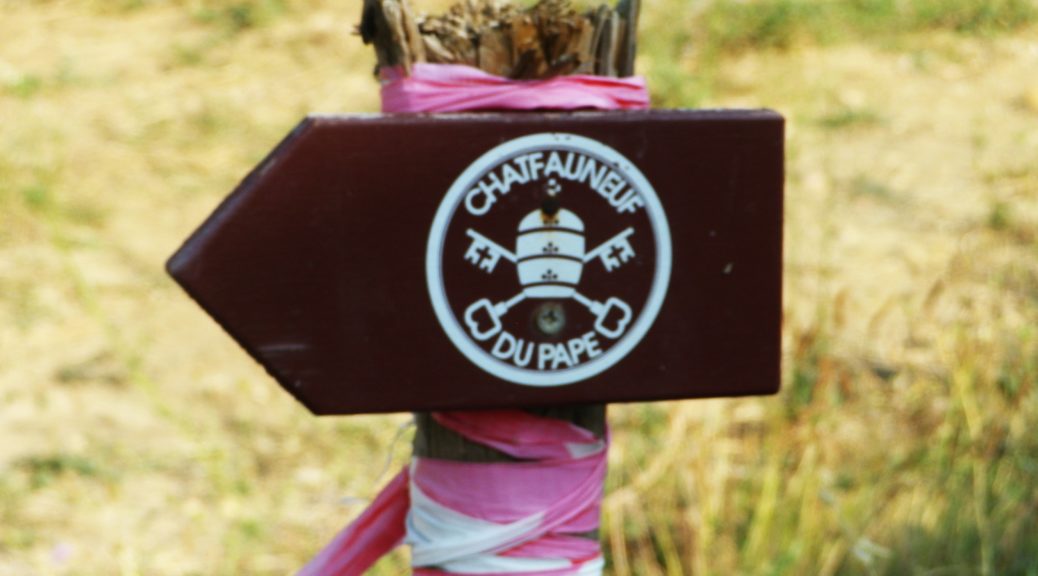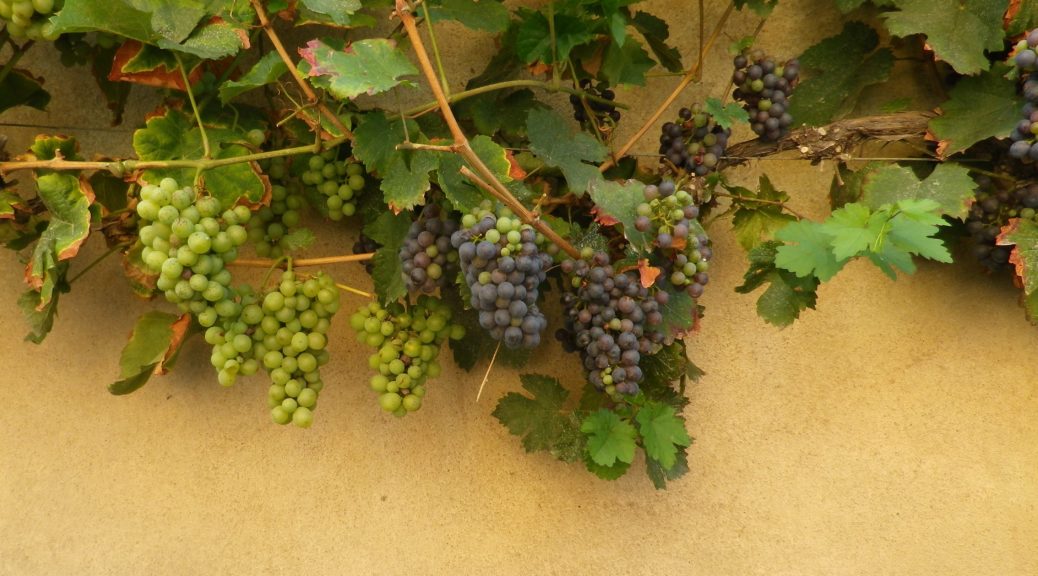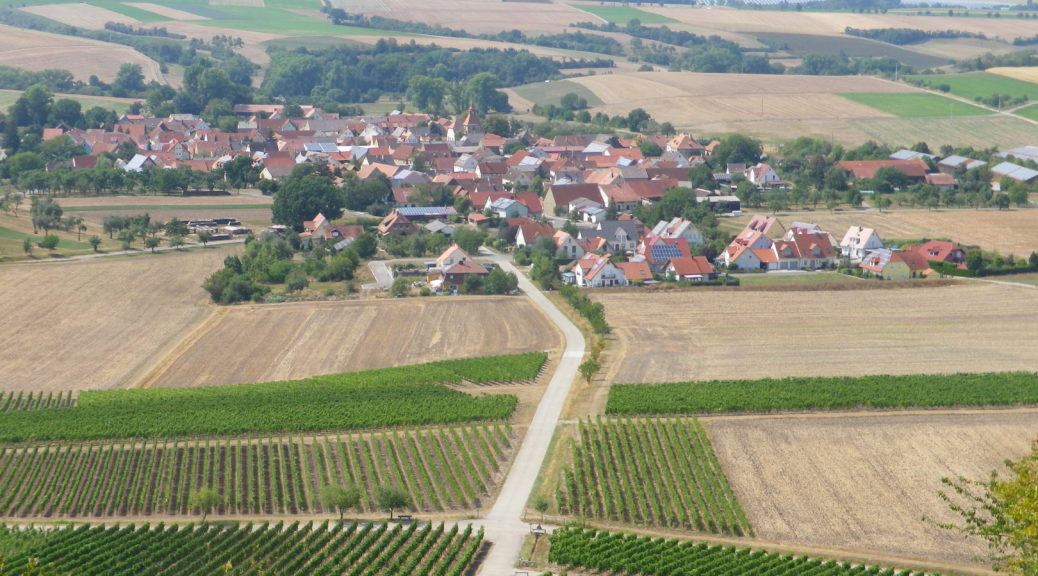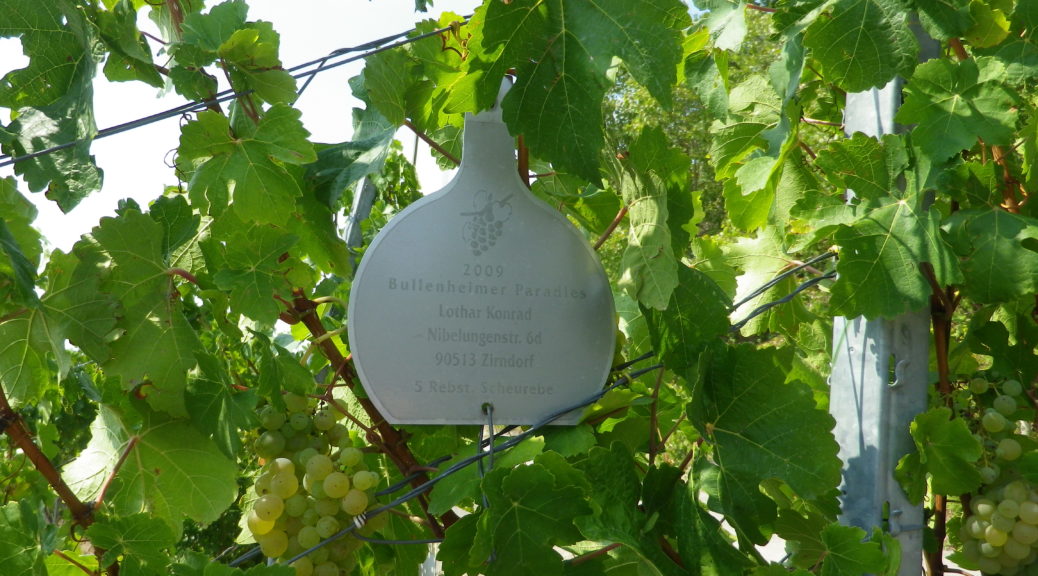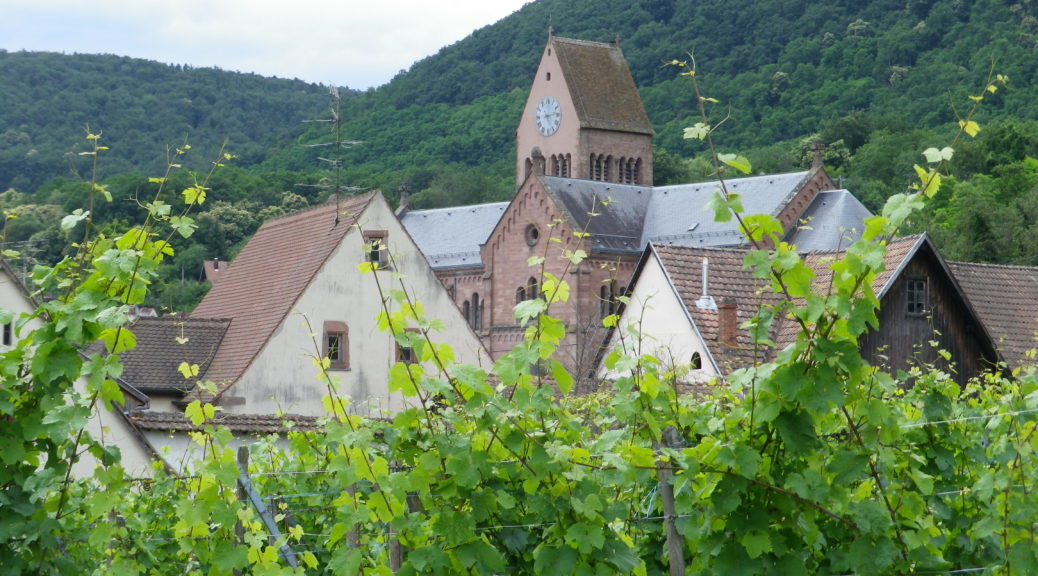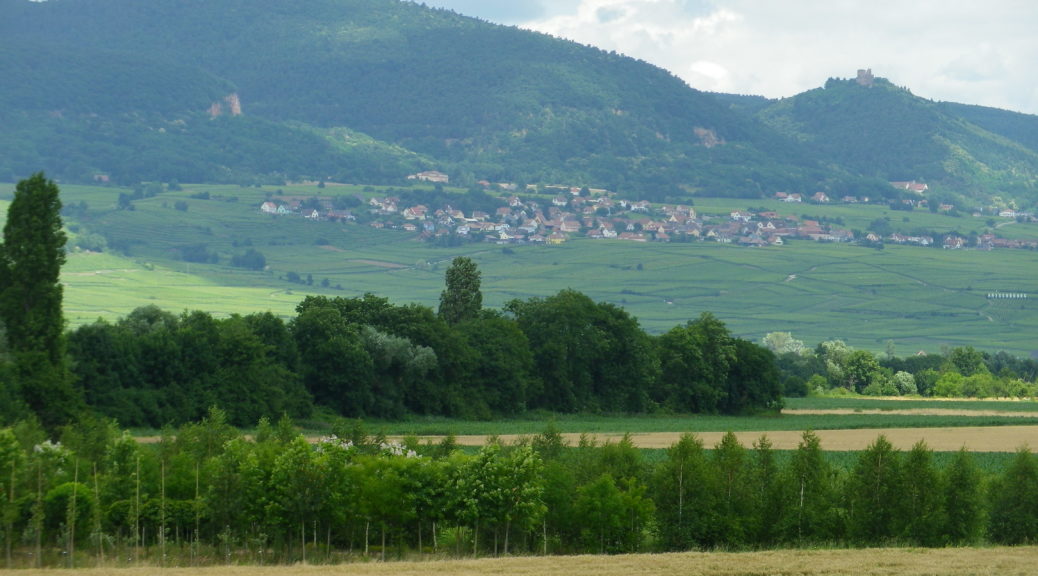A New Castle Makes New Wine From Old
In the early 14th century, a Pope decided to make a new residence (his Chateauneuf, or New Castle) in the countryside a few miles north of Avignon. The intent was to use this as a summer residence, away from the noise and heat of Avignon. Vines have been in this area, around what is now the village of Chateauneuf du Pape, for at least a couple of millennia. The wine it produced, though, was not particularly good. But with papal money and interest, the wine improved greatly over time. Nowadays, Chateauneuf du Pape wine is one of the most iconic wines of the world.
So, with great enthusiasm, I headed to the village to hike an easy trail through its vineyards, try its wines, and see its “New Castle”.
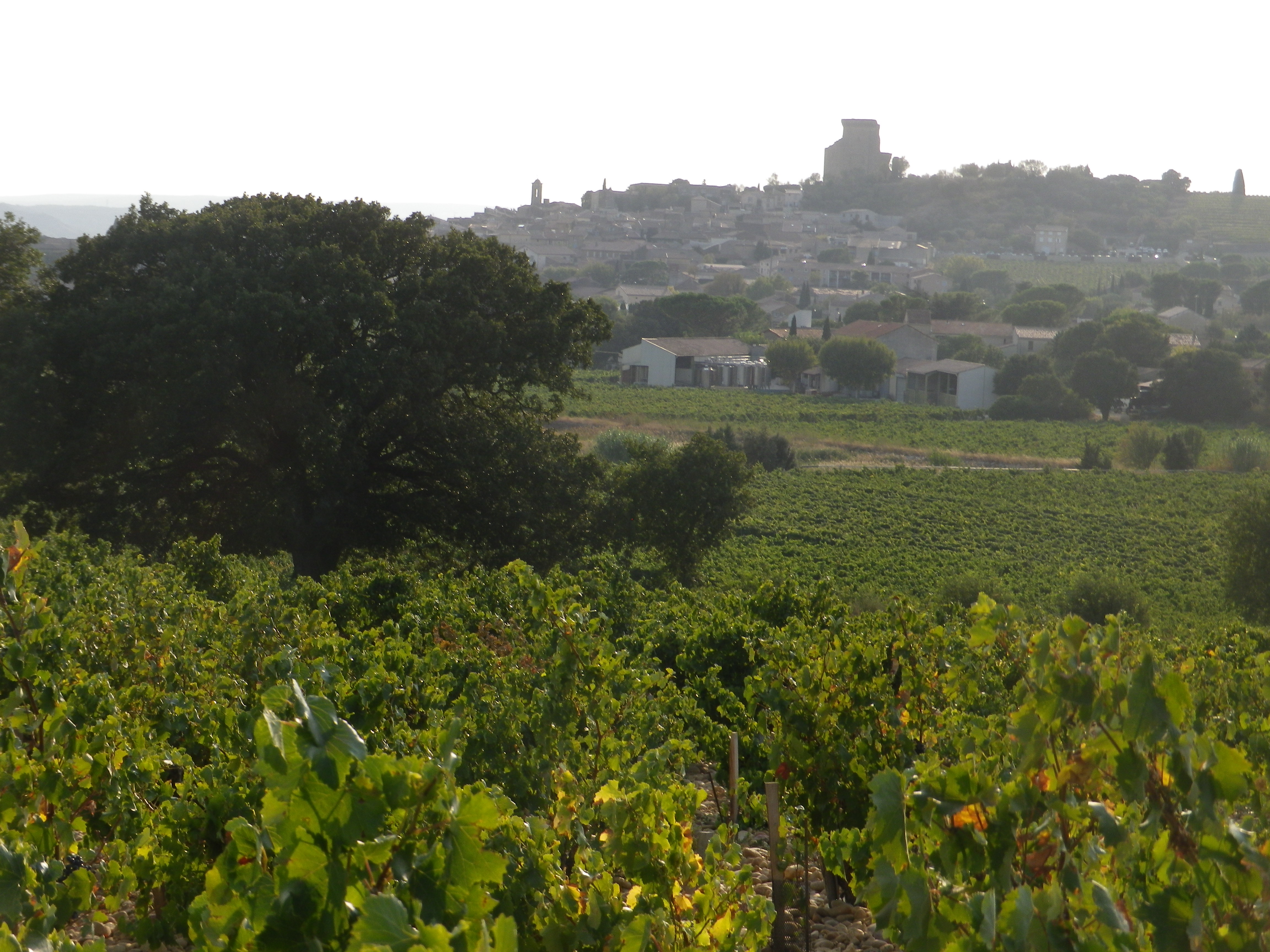
To be honest – the vineyards make the trip worthwhile here. They surround the village completely. This trail passed through the vineyards to the east of the village. My first surprise was seeing the galets. I had heard of them, of course. These stones both help keep weeds down, and help retain the sun’s heat (from day into night). But seeing them on the ground, and appreciating their size and texture, was another thing altogether. In one place, they were several deep on the ground, looking like so many harvested Russet potatoes, still lying in the field. (Caution: It makes for slow(er) walking.) Later, I came to a cut in a bank, and the layers were visible in the soil for at least a couple of feet!
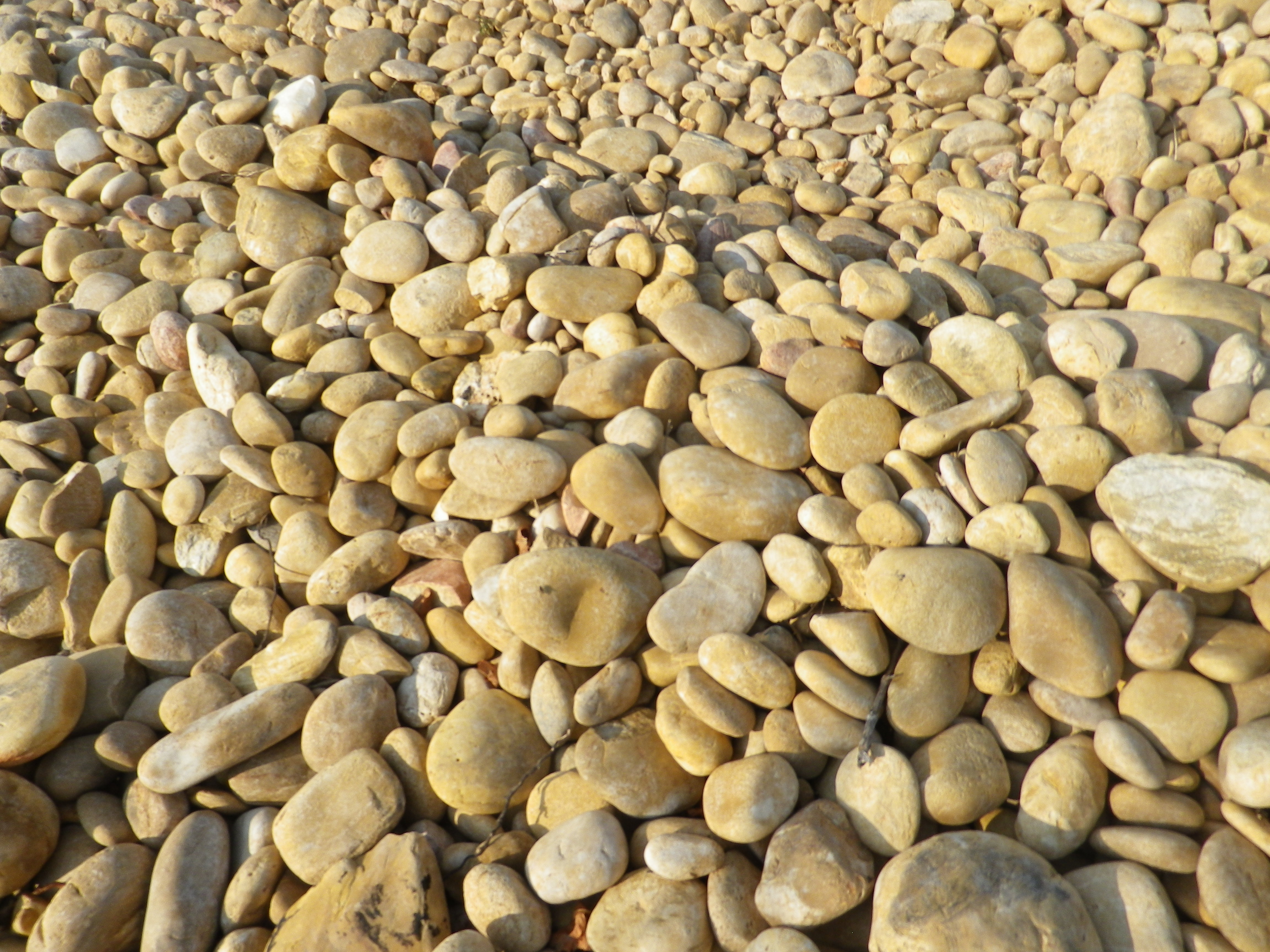
Another thing to notice along this trail, is the number of different vine pruning/training techniques. Usually you will see one, maybe two, types of pruning. But here, they even had the Gobelet (vines shaped like a goblet), in addition to the Guyot and the Cordon de Royat. This and other interesting tidbits of information about the terroir and the viticultural practices here may be found on education boards all along the trail. (While the trail’s boards are only in French, a brochure from the tourism office (https://en.chateauneuf.com/le-sentier-viticole) provides explanations for each board in French and English.)
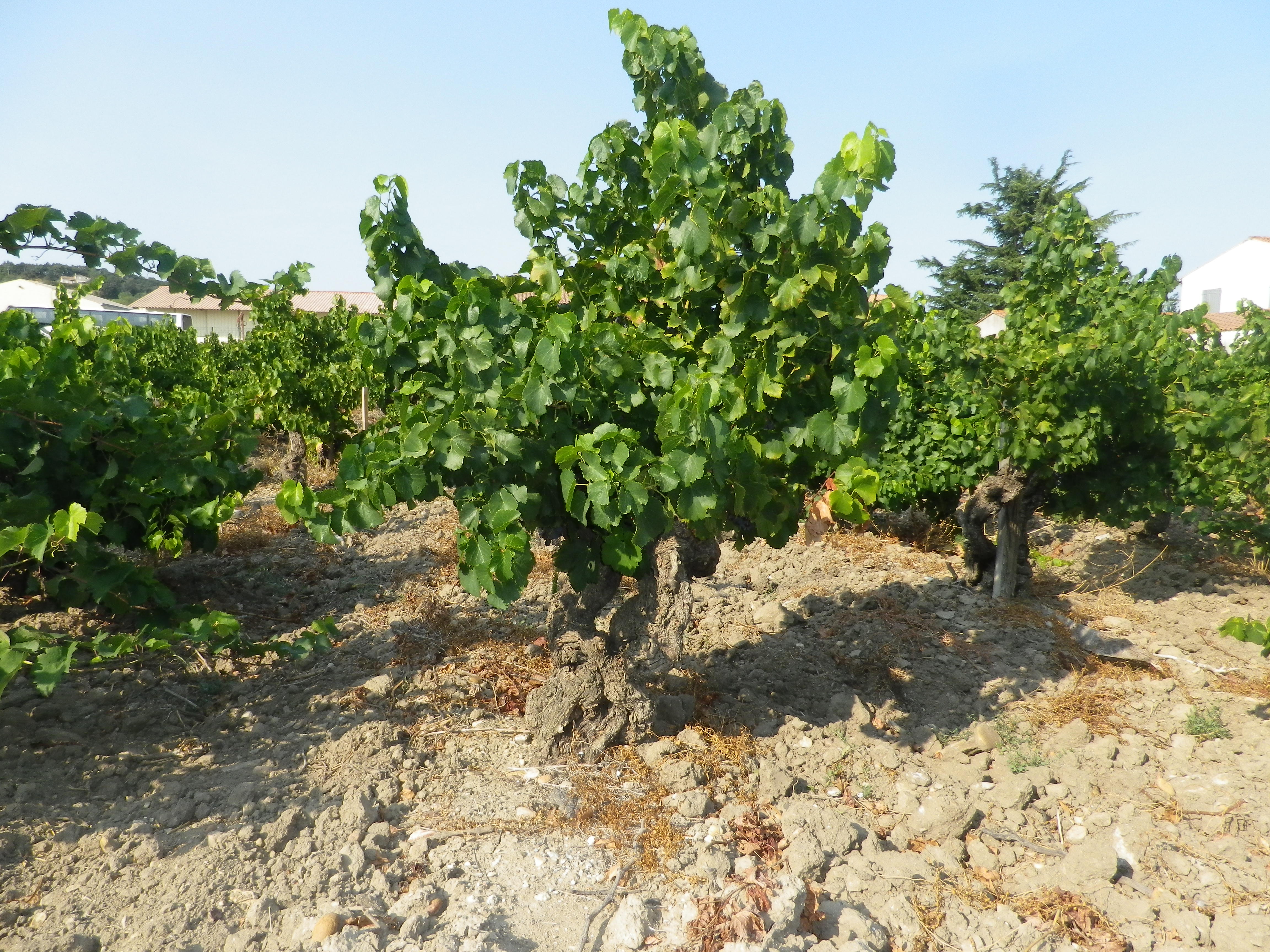
Finally, I noticed that this was an undulating land – more than I had expected or realized at first. With each rise and fall of a slope, around each turn of a vineyard or hedge row, I had a different long distance view. Sometimes Chateauneuf du Pape would disappear from view completely. Other times, I found myself facing the white slopes of Mount Ventoux. Cresting another slope, my old haunts the Alpilles, by Vacqueyras and Gigondas, magically appeared. Yet, I never saw the Rhone River, although the village lies not too far from it.
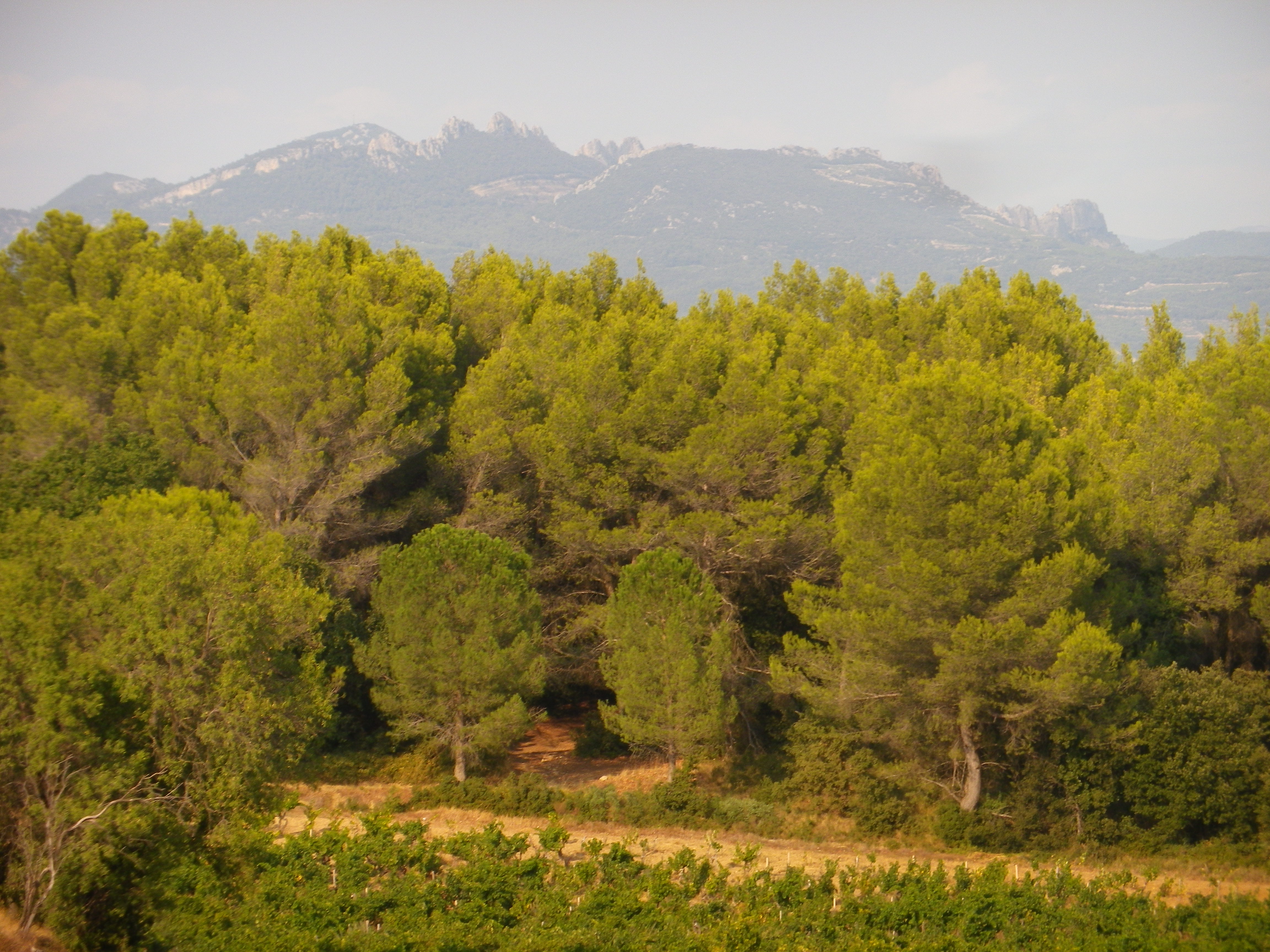
After I passed through the section of vineyards known as the Crau (which means stone in Provencal – per the board), I followed the trail through a wooded section. It provides the only shade for hikers on this itinerary, and is welcome, as it immediately precedes the final section of the trail, a walk along the road back to the starting point on the outskirts of the village
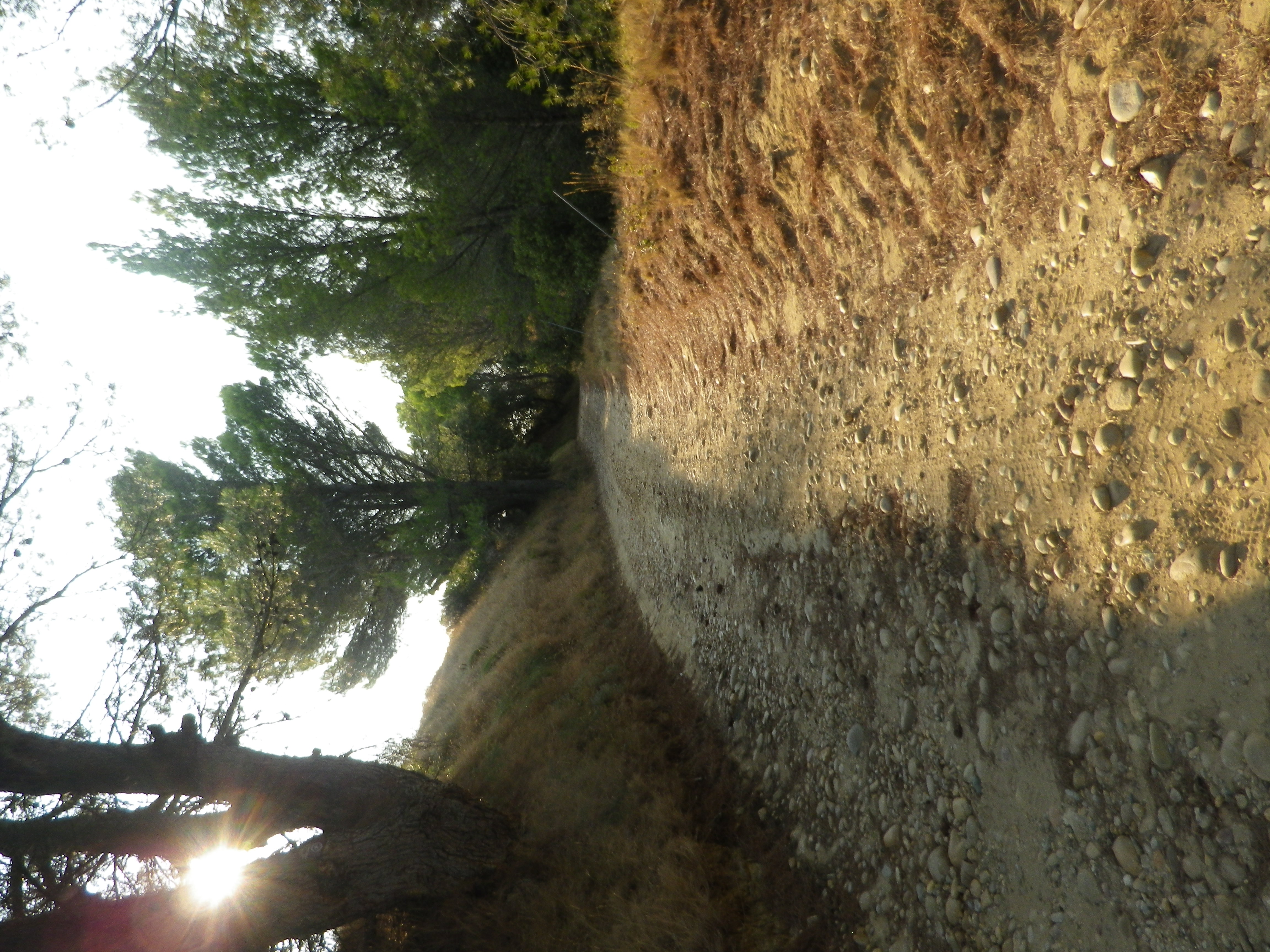
To return to the car, I had to walk back through the village. For such a famous wine, the village was fairly small, (and the tourism infrastructure even smaller). Its castle is a mere ruin, albeit a highly photographed one. Nonetheless, it was exciting to visit the place that may be called the birthplace of the Appellation d’Origine Controlee system, and home to former Popes and famous vineyards. Then, of course, there is the wine – in so many wineries, so many shops – to explore!
Wine Notes: Chateauneuf du Pape
What I Learned
Located in the Southern Rhone wine region of France, Chateauneuf du Pape is one of the world’s most iconic French wines. It has historically been one of France’s most exclusive wines. Since the days of the Popes at Avignon, this wine over time improved, until it became one of the most sought after wines in Europe. Nearby, and even not so near-by wine-makers began to capitalize on its fame, and labelled their own wines “Chateauneuf du Pape.” Indignant Chateauneuf du Pape villagers lobbied the national assembly to pass a law, thus inspiring the Appellation d’Origine Controlee system.
The wines themselves (both red and white) are blends. Traditionally, up to thirteen grapes (both red and white) may be used in the red blend, although most wine-makers rely on fewer than that, and most use at least some Grenache. Other red grape varietals often include another Rhone Valley favorite Syrah, and Southern Rhone stand-ins Mourvedre and Cinsault.
White Chateauneuf du Pape wines are more difficult to find because less than ten percent of the total Chateauneuf du Pape wine production is white wine. No red varietals are allowed in the white wines, leaving the winemakers only six varietals, among them the Grenache Blanc, the Southern Rhone valley perennials Roussanne, Bourboulenc, Clairette and Picpoul.
Chateauneuf du Pape vineyards are also famous for their galets. Rounded stones brought down by the Rhone over eons, they cover the vineyards in many places. Imagine stones akin to Russet potatoes strewn throughout the vineyards! They serve the practical function of reducing weeds, and catching the heat of the sun by day, releasing it at night.
What I Tasted
2015 Le P’tit Plaisir, Vin de France, Domaine Eddie Feraud: A dry white wine cuvee (Grenache, Clairette, Muscat) with medium minus gold color, spice, wood and slight floral nose, with vanilla, floral and slight wood flavors, medium acidity, smooth overall.
2015 Chateauneuf du Pape Blanc, Appellation Chateauneuf du Pape Controlee, Domaine Andre Mathieu: A dry white wine with a medium yellow gold color; mineral and floral nose, along with vanilla and toasted nuts flavors; medium acidity, with a very suave mouth feel and very smooth finish.
2014 Chateauneuf du Pape Rouge, Appellation Chateauneuf du Pape Controlee, Domaine Andre Mathieu: A very dry red wine with dark minus garnet color; tobacco and red cherry nose with herbal and spicy notes, slight leather and cherry flavors, with notes of smoke, and cedar; medium tannins, very dry, with a smooth finish ending on a wisp of smoke.
2013 Chateauneuf du Pape Rouge, Tradition, Appellation Chateauneuf du Pape Controlee, Chateau de la Gardine: A dry red wine with dark garnet color; nose of spice, smoke, stewed plums, with flavors of leather, smoke, stewed red fruits; medium plus tannins, long finish.
2012 Chateauneuf du Pape Rouge, Appellation Chateauneuf du Pape Controlee, Chateau Mont-Redon: A dry red wine with dark garnet color; nose of leather and spice, blackberry, vanilla and oak flavors; medium tannins with a smooth finish.
Escapade au Coeur du Vignoble: Trail in a Nutshell
Trail Name: Escapade au Coeur du Vignoble de Chateauneuf du Pape
Trail Type: an easy short distance circuit; well-maintained and almost about half paved, and half rough, trail surface; marking on the trail is ok, but take a map.
Length:
Total – 7.5 kilometers/4.6 miles
Convenient to:
Avignon or Orange, France
Marking:
Small maroon colored square with the Chateauneuf coat of arms (occasionally), and (15) education boards
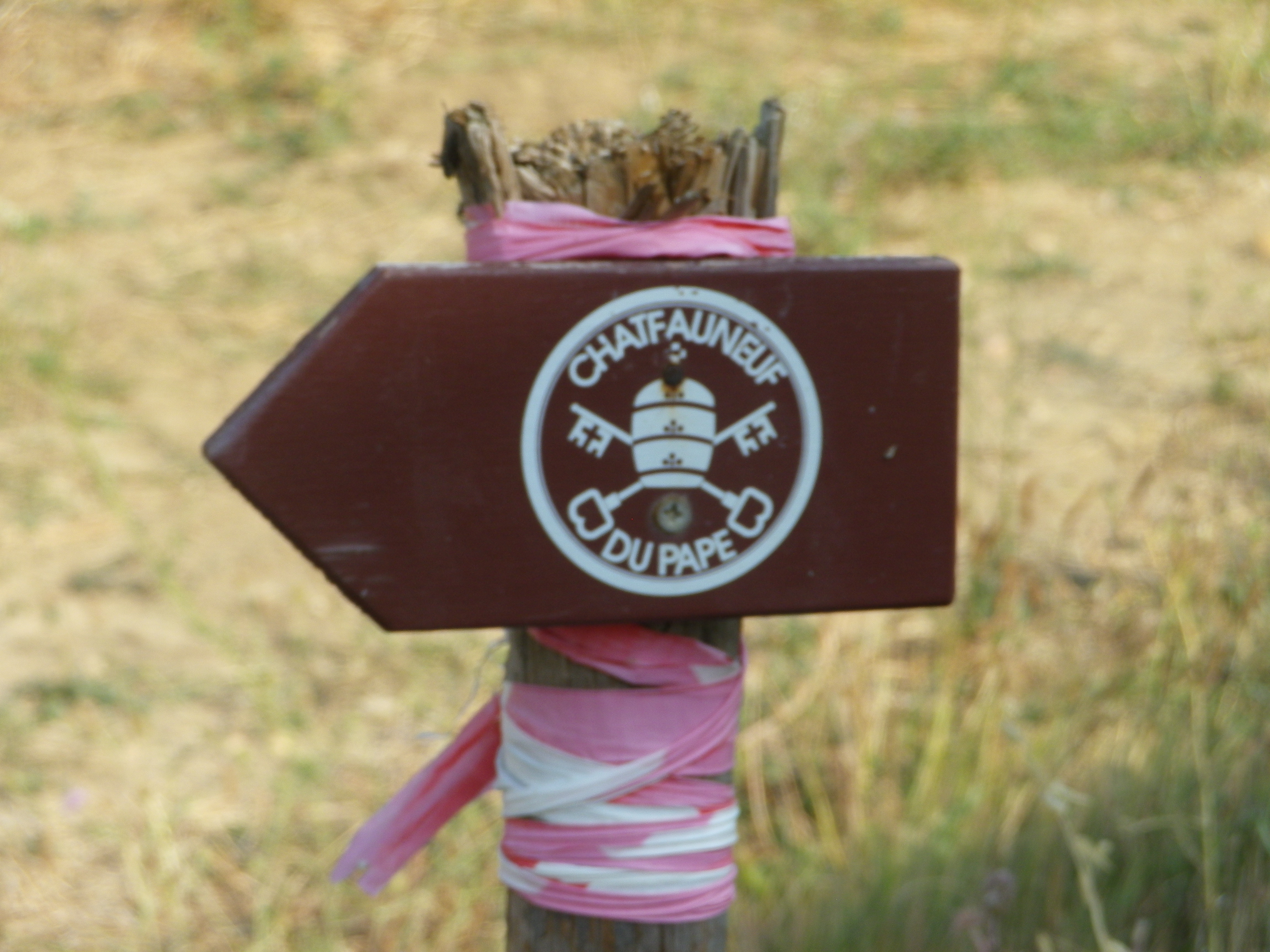
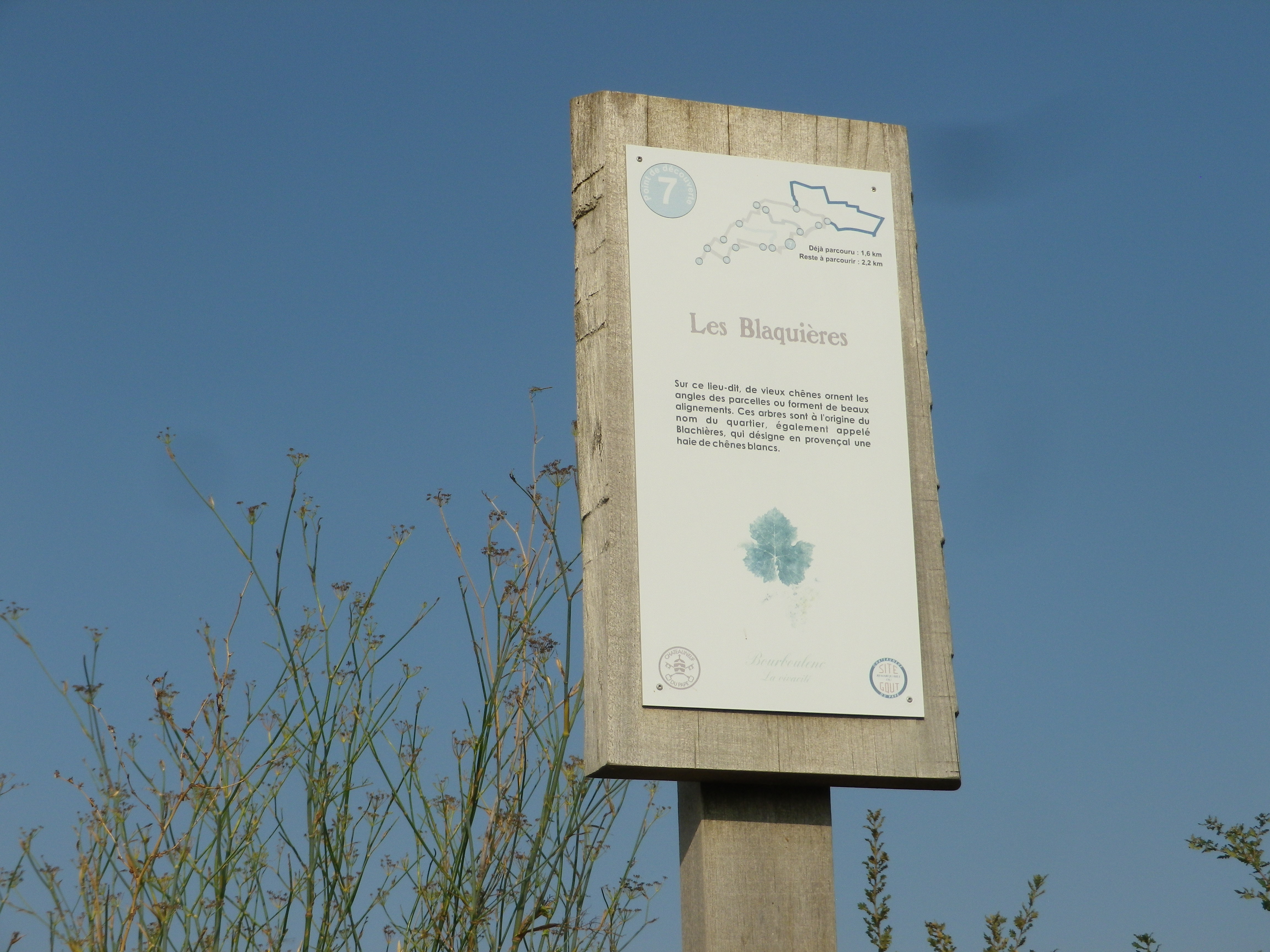
Trail Description:
A pleasant, but mostly unshaded, itinerary through parts of the famous vineyard area of Chateauneuf du Pape, providing great views, tips on local viticultural practices, and fun for the whole family (providing you wear sturdy footwear!).
Trailhead:
Chateauneuf du Pape: Avenue Louis Pasteur
Parking:
In the center of the village, not much, but there is more
Public Transportation Options:
Rail: None, but the closest stations are in Orange, Courthezon or Sorgues, all on the Orange to Avignon line. Check https://www.sncf.com/fr
Bus: Buses on the Route Orange-Sorgues, on Line 922
Suggested Stages:
Not applicable
Trail Itinerary-Reference Points:
Chateauneuf du Pape: Avenue Louis Pasteur-Chemin de la Font du Pape, to the first educative panel, through vineyards to Chemin de la Coste Froide, Chemin de la Montalivet (a narrow track), Chemin de la Nerthe, (turning onto a narrow track called Chemin Draille de la Crau, circling the vineyards of Charbonnieres Est, stair-stepping back west to Chemin de Charbonnieres, onto Route de Courthezon, then right onto a track to rejoin the original trail passing along a small wood, vineyards, then through woods back onto Chemin de la Montalivet; left onto Route de Courthezon/D92, following it back into the village
Representative Trail Photos:
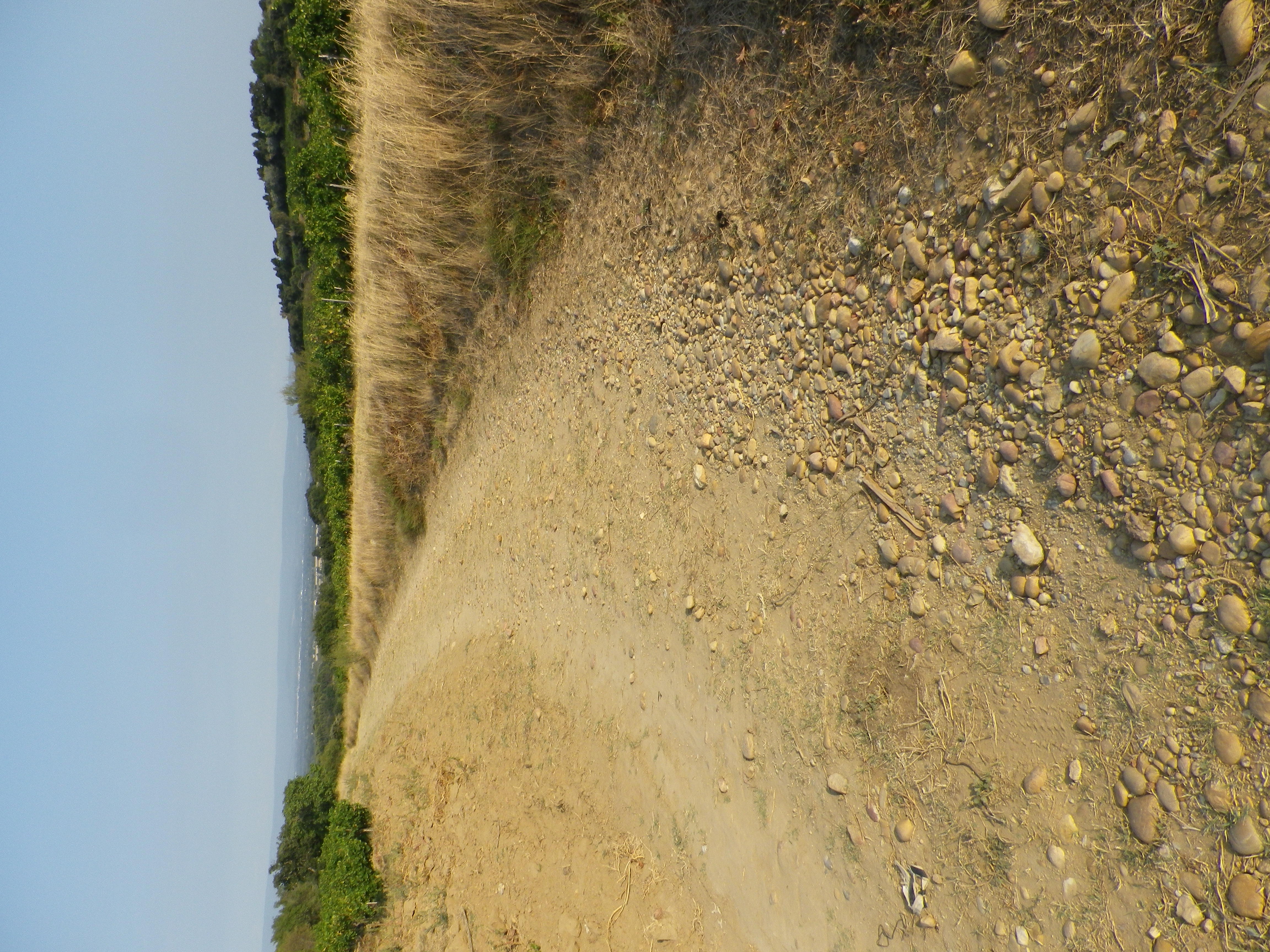
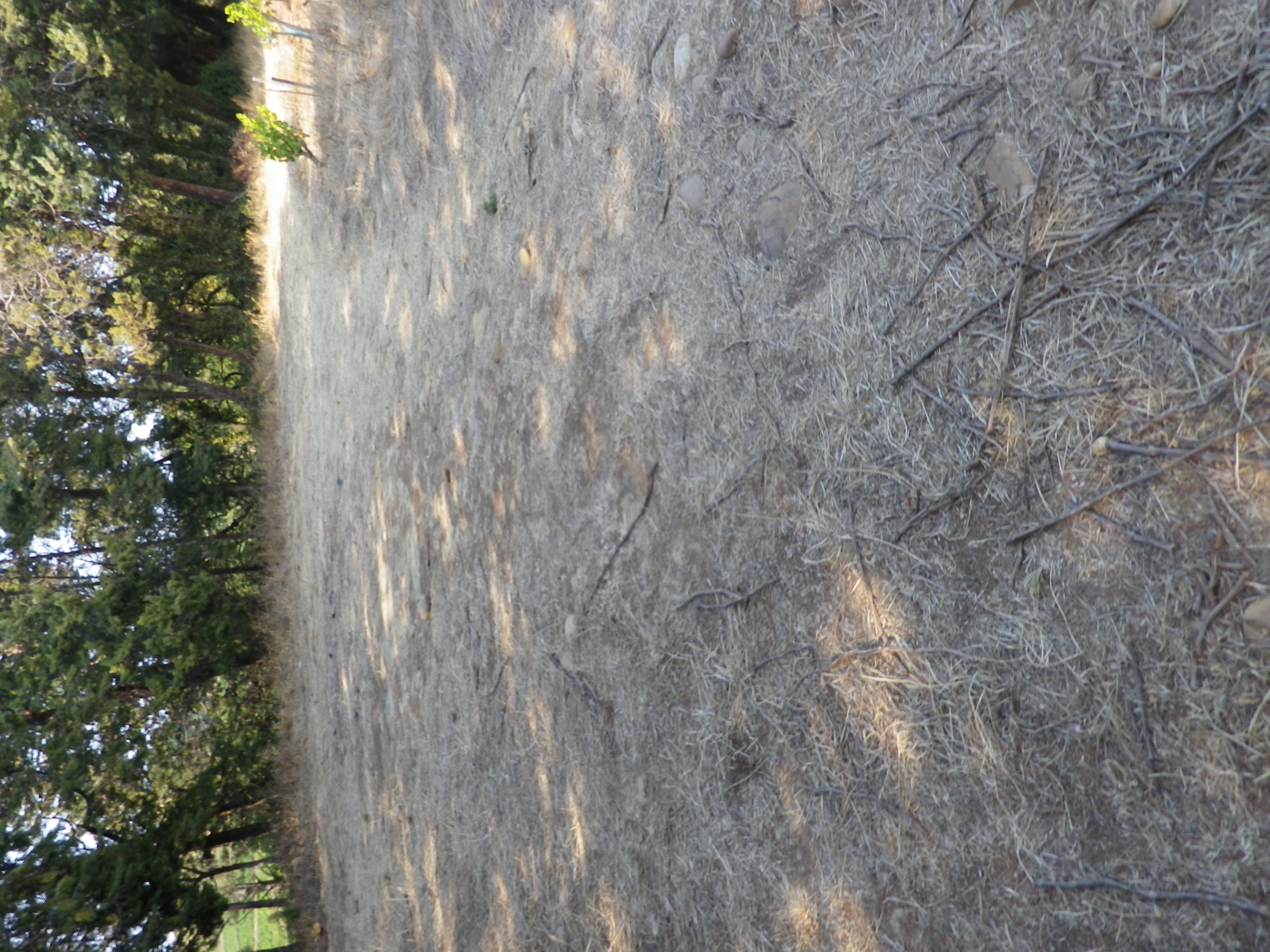
Restrooms:
None observed
Attractions on or near Trail:
Chateauneuf du Pape, Avenue Saint-Pierre de Luxembourg: Musee du Vin Brotte, offers audio-guided tours, and a wine tasting.
Tasting along the Trail:
Both in the village and along the trail there are plenty of wineries to choose from!
Alternative Options:
Hiking: Chateauneuf du Pape and its Environments is a 10.8 km circuit route that has more elevation, and covers a wider variety of scenery, from village to river, as well as through vineyards. See https://www.visorando.com/randonnee-chateauneuf-du-pape-et-son-environnement/
Biking: From the Antique Stones of Orange, to the Galets (River Stones) of Chateauneuf du Pape, a challenging 35 kilometer circuit, beginning in Orange, famous for its Roman theater and other ruins, to Chateauneuf du Pape, some of which follows the well-known Via Rhona bike trail (from Lyon). See https://www.provence-cycling.co.uk/equipment/orange/cycle-route-from-the-stone-to-the-pebbly-terroir/provence-713016-2.html
Additional Information:
Regional: https://www.france-voyage.com/cities-towns/chateauneuf-du-pape-33685/tourist-office-chateauneuf-pape-7166.htm ; and more specifically for this area https://www.poptourisme.fr/
Trail specific: https://www.outdooractive.com/en/route/hiking-route/france/sentier-viticole-chateauneuf-du-pape/266646253/
Comments:
This route leads past 15 numbered education boards about vineyards and winemaking, in order.
The trail is designed with short-cuts (shorter versions), or an extension (longer version) (at or near sign 10, ) to the Charbonnieres Est and the Crau vineyard areas, which adds about 2 km, (1.25 miles) to make it about 7.5 kilometers in total.
Gallery September 2023
Communing with Vines
This hike can be defined as slow hiking. According to the Cambridge Dictionary, slow hiking is the act of going on a long walk through countryside, without the pressure of going fast, or climbing hills, or making a distance. It is meant to be an activity accessible to all fitness levels, that predisposes participants for actually enjoying nature. Thus, it sets up a framework for communing with nature.
The Steigerwald area I hiked is ideal for slow tourism, defined as far from mass tourism sites, with a focus on local culture, history and traditions. It is characterized by low (and slow) mobility, emphasizing sustainability. The Steigerwald wine district is surely Franconia’s least known district. Iphofen (see here), and Bad Windsheim (see here), are the two biggest towns – delightful, but small. Agricultural pursuits, mostly devoted to vines and grains, cover much of the rest of the area. Thus, I could slow hike in a slow tourism area, and take time to reflect on vines and communities supporting them.
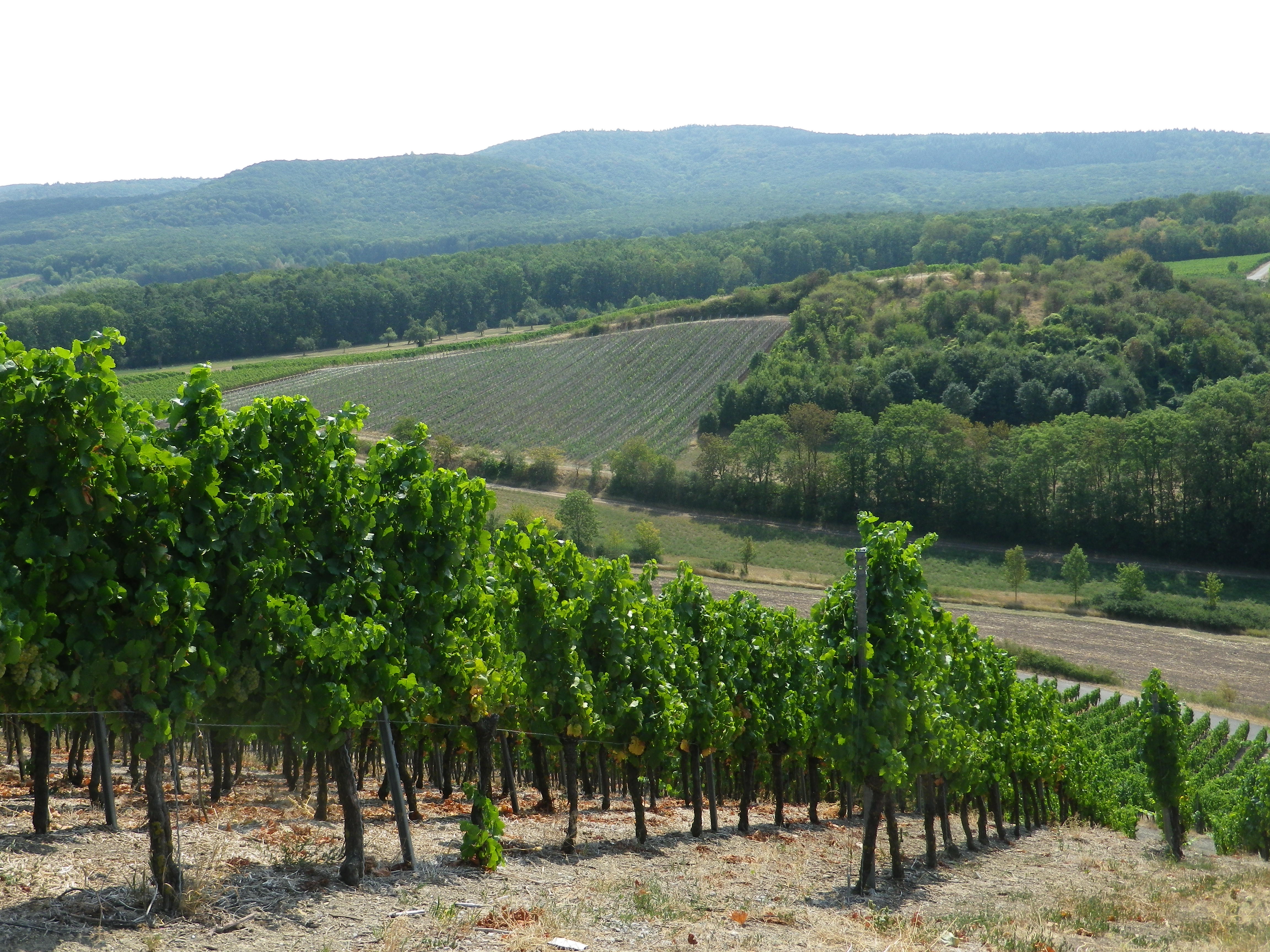
Mainly though, this area is known for the Steigerwald Nature Park, which covers about 431 square miles, in the Franconian/Bavarian border area west of Nuremberg. The hills are heavily forested and popular with some hikers for their unspoiled nature. My hike though, on the southwest corner of the park, lay right at the junction of the trees and vines. Not only could I enjoy both vineyards and forest, I could do so in peace and quiet.
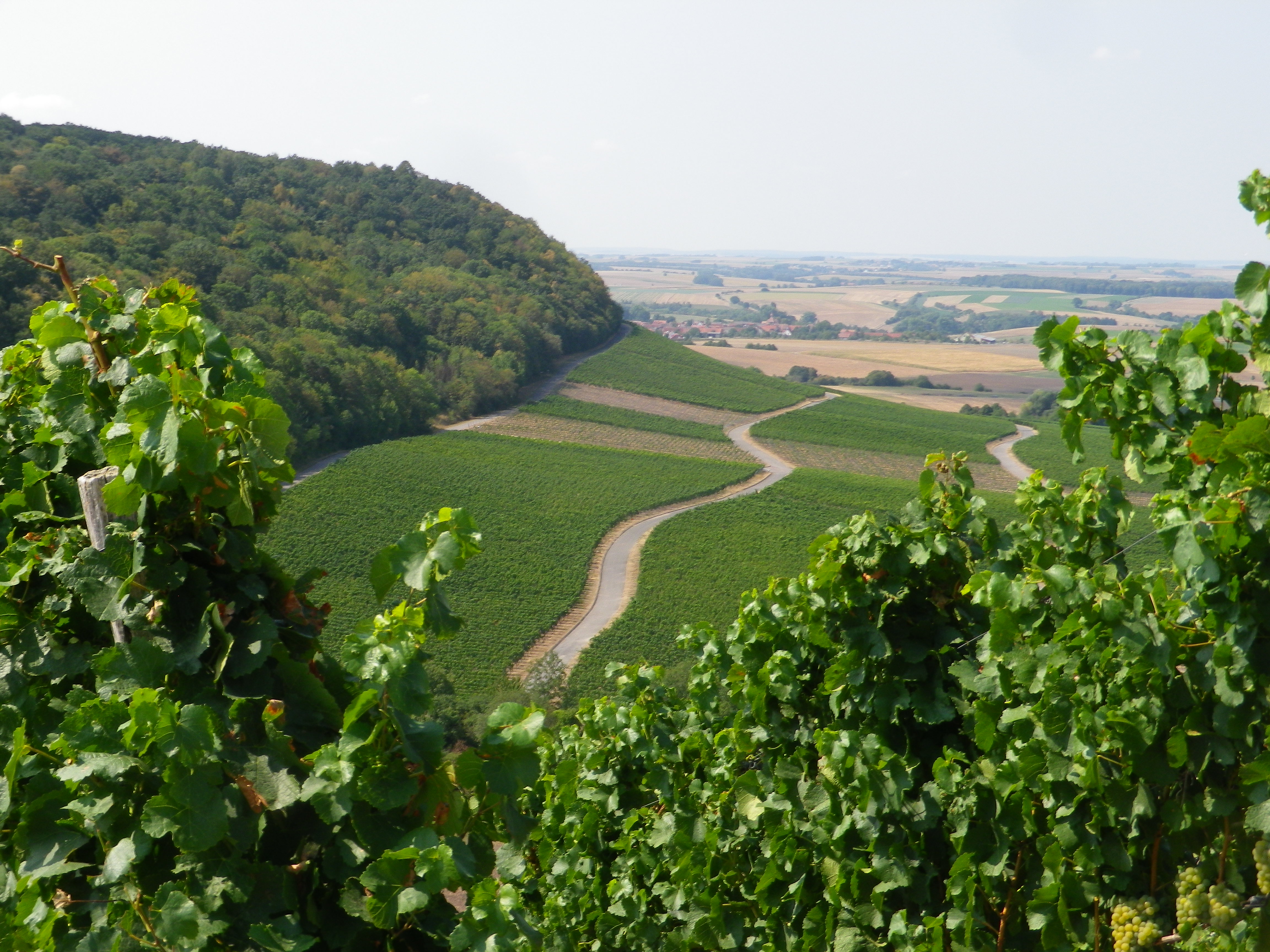
I began just below the Weinparadiesscheune, a popular wine-bar with local wine (and food) on offer. Early morning patrons, on that warm, sunny late August day, began to fill up the outdoor seats. This part of the hike remained on asphalt as it went up the western side of the hill, along the upper reaches of vines facing the villages of Bullenheim, Seinsheim and Huettenheim.
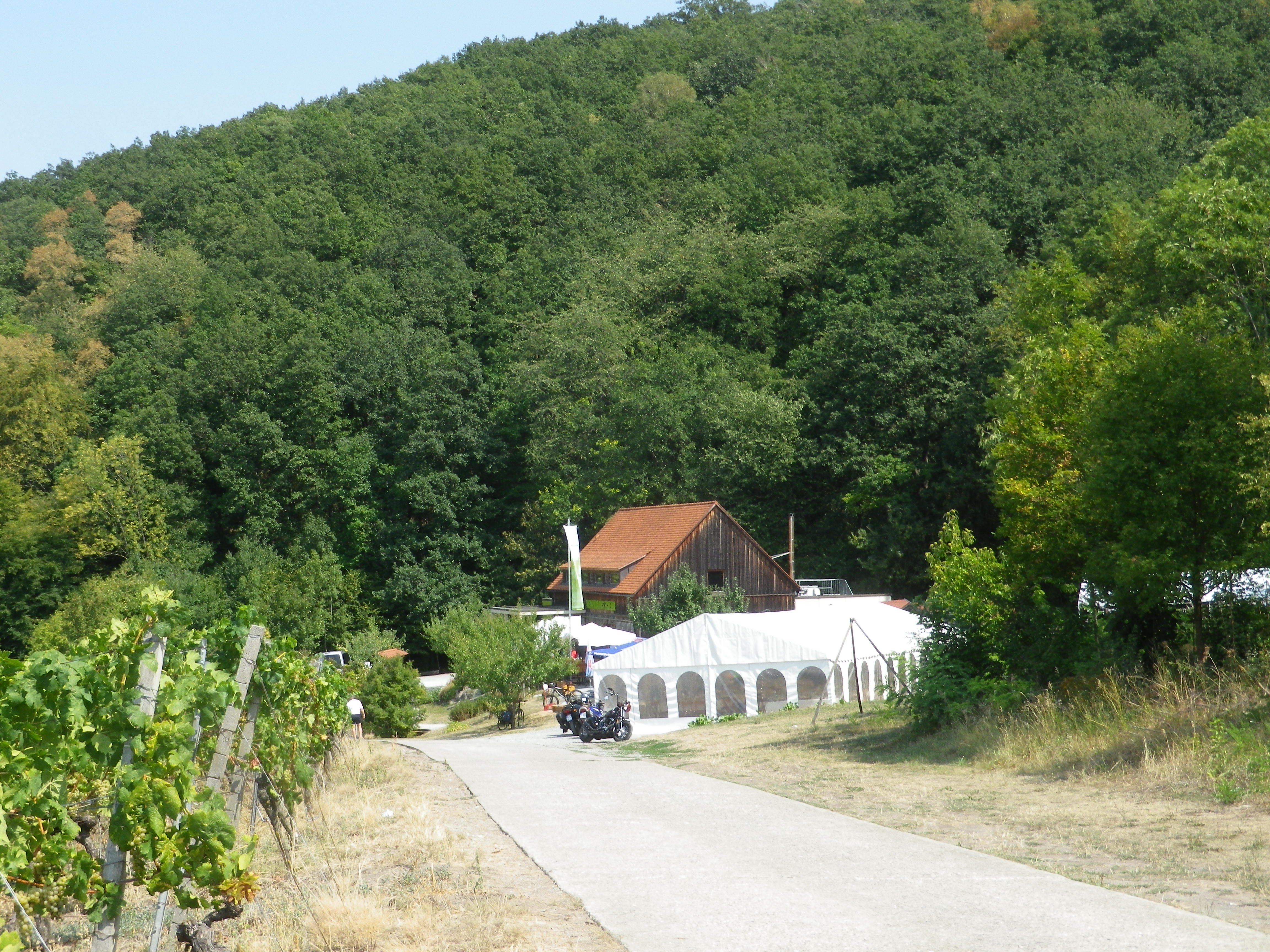
Vintners from these small villages work the vines on the short, but steep, slopes, producing Silvaner, Mueller-Thurgau and Bacchus wine, named after the Greco-Roman god of wine. The Bacchus varietal is relatively new, but it has taken hold in this region (one of the few places it may be found). Like the god, Bacchus wine is popular, and inspires (when taken in moderation, of course!)
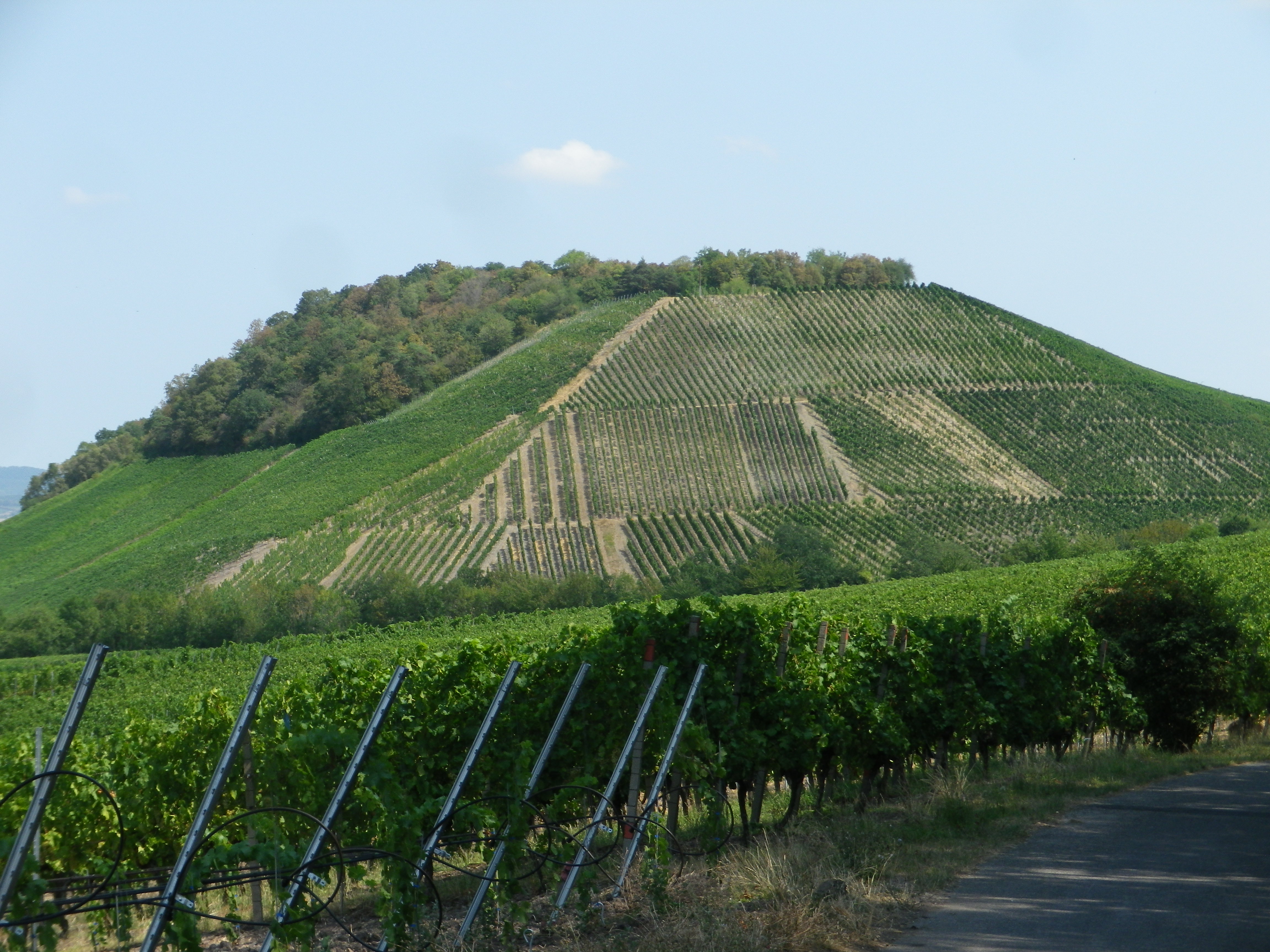
After a steep climb off the asphalt and into the woods, I was onto the Tannenberg (Pine Mountain), nowadays mostly devoid of trees and covered in vines instead. On the north side of this hill overlooking Huettenheim, there is a Jewish cemetery. In a quiet spot, well suited for contemplation, reminiscent of two similar cemeteries in remote areas of Baden I’d seen, recalling that once vibrant Jewish communities coexisted within even remote villages.
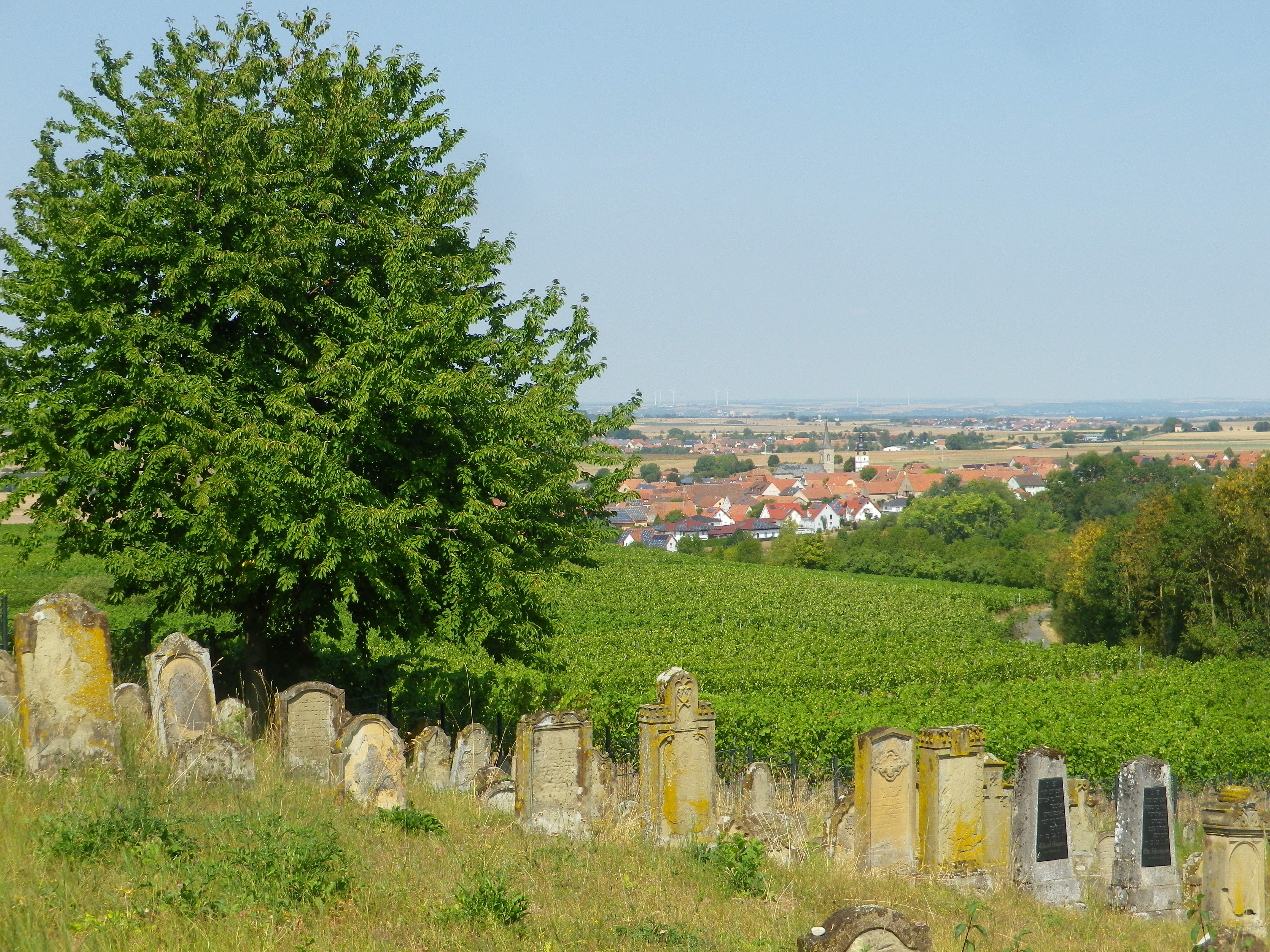
After that, the trail ran south along a shallow valley separating it from the main Steigerwald park. Once leaving the Tannenberg hill, the trail entered woodlands again. As the modest incline increased so did the heat, but fortunately now, the meandering trail was shaded by majestic trees.
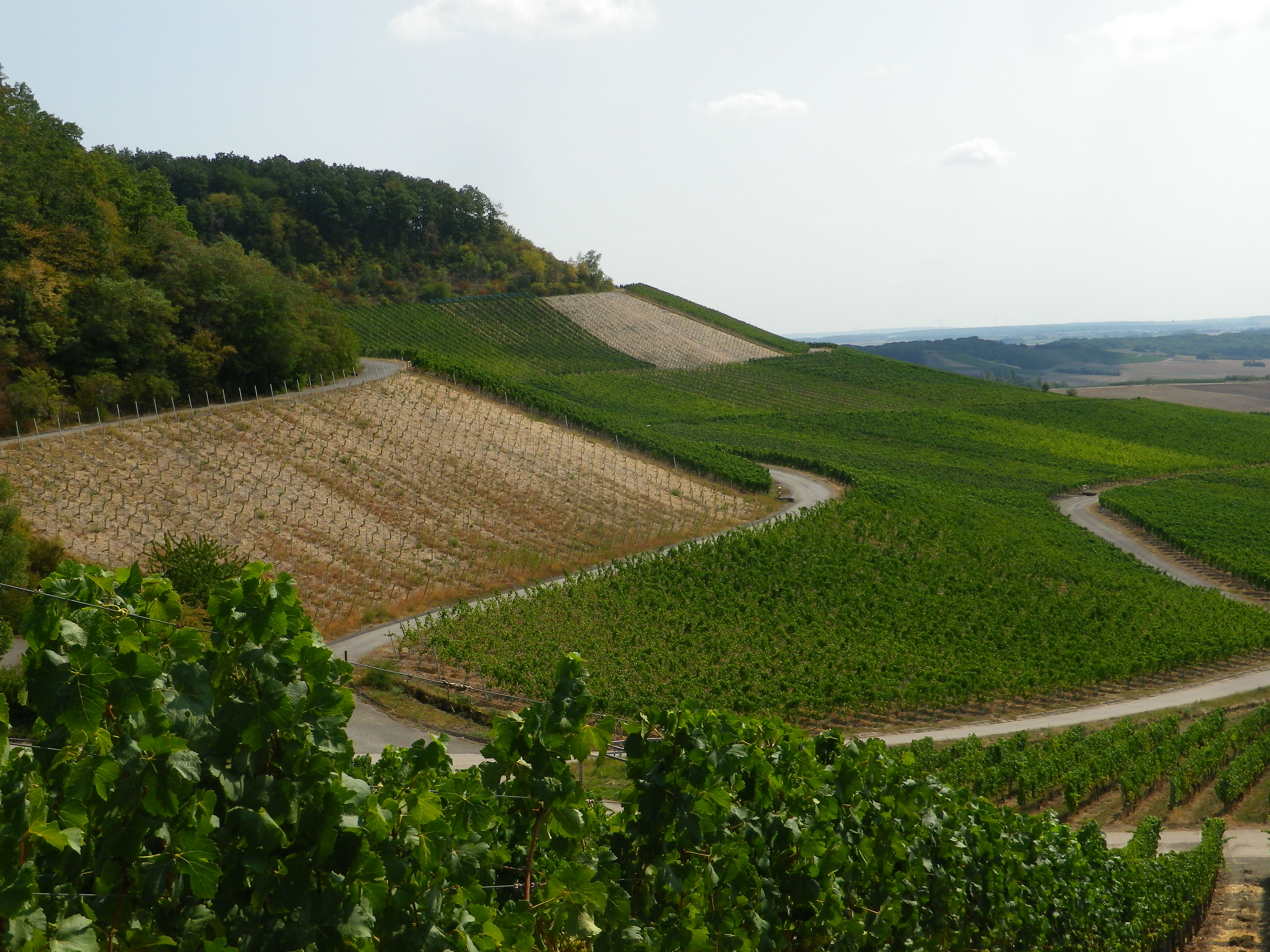
It was in this same forest, according to legend, that Empress Kunigunde, lost her way. She made an oath to God that she would found a church there, if she could find her way out of the woods. Sure enough, right off the trail lay the ruins of Kunigunde’s church. (The only problematic issue being the fact that the ruins date to about 400 years after her death in 1033.) Nonetheless, they provide a nice opportunity to relax, soak up the atmosphere of an earlier era, and enjoy the birdsong.
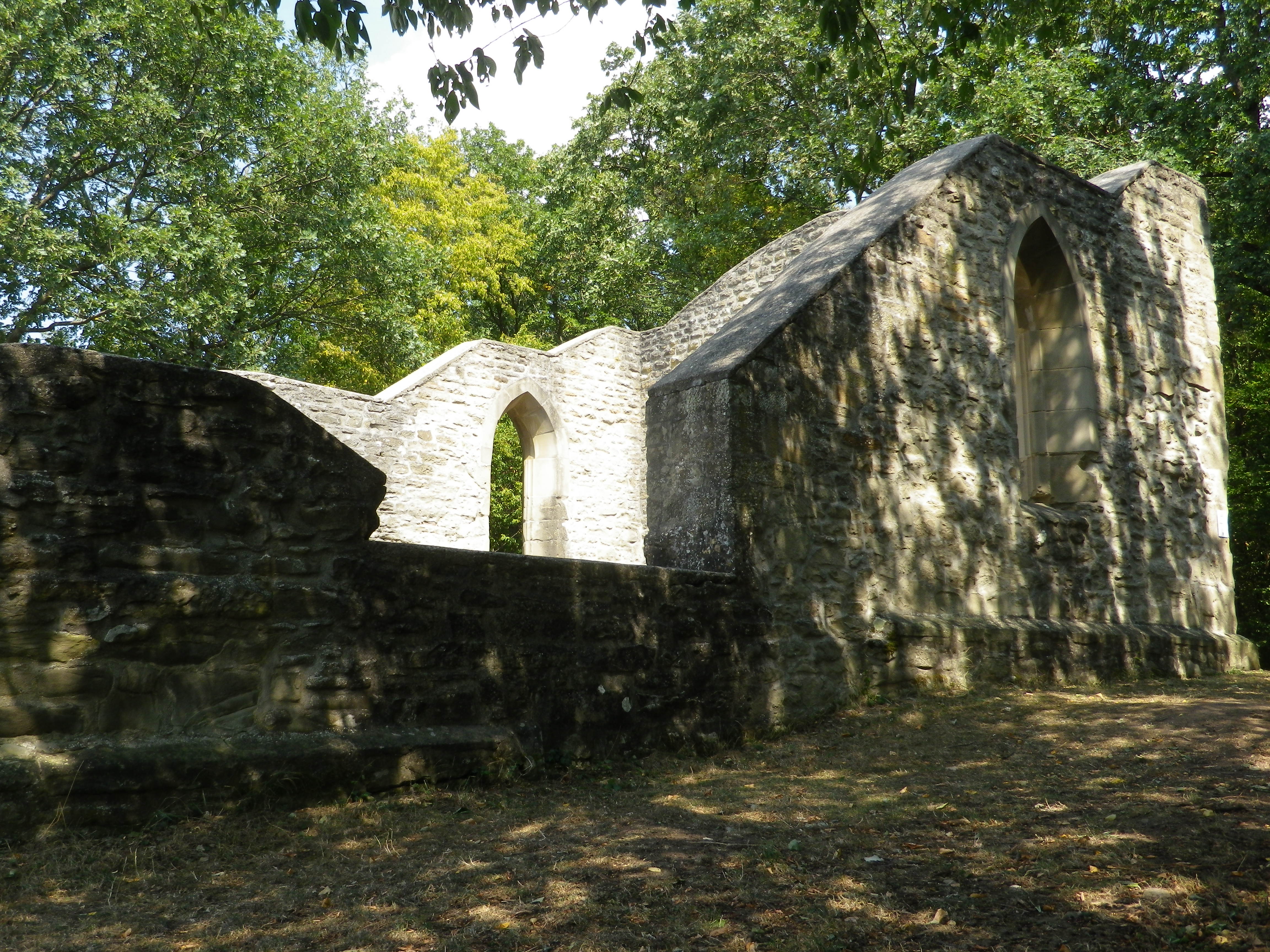
After my contemplations on a Greco-Roman god, a Catholic church, and a former Jewish community, I realized that like the Greco-Roman communities of old, and the Jewish and Catholic communities, all shared an appreciation of wine that transcended their differences. Such is often the way with wine aficionados as well. Completing the circuit, I made my way back to the Weinparadiesscheune, to enjoy a glass or two of the local wine, made right here, in full communion with nature and fellow wine-lovers, as has been done for centuries.
Wine Notes: Seinsheim Bullenheim
What I Learned
Of the Franconia (Franken) wine region’s districts, the Steigerwald district is undoubtedly less well-known than the other two (the Maindreieck around Wuerzburg, and the Mainviereck), and consequently, one of the least visited. The Steigerwald is a tranquil area, focused largely on agriculture. One major attraction is the relatively large Steigerwald Nature park, with wide swathes of tree-covered hills. But on the edges of those hills are vineyards. The vineyard area is known as Frankenberger Schlossstueck, with three vineyards – the Hohenbuehl, the Tannenberg, and the Paradies, belonging to the villages of Seinsheim, Huettenheim and Bullenheim respectively.
Mueller-Thurgau, Silvaner and Bacchus are the three most common grape varieties planted here. The Bacchus varietal was created by crossing a Riesling with a Silvaner, then with a Mueller-Thurgau. The three parent varietals all do relatively well in cooler climate, which is why these, along with Bacchus, are the most planted varietals in this district. These grapes tend to produce light, fruity, white wines, a delight to drink chilled. Normally neither as acidic, nor as aromatic as Riesling, both the Silvaner and Bacchus wines are less-intense alternatives to Riesling, and are found almost only in Franconia.
What I Tasted
2017 Mueller-Thurgau, Kabinett, Trocken, Paradies Wein: A dry white wine with medium minus gold color; nose of green apple and gooseberry, with vanilla, green apple, and slight stone fruit flavors; medium plus acidity, with a tart lengthy finish.
2017 Bacchus, Kabinett, Halbtrocken, Winzerhof Klaus Markert (Weigenheim): A semi-dry white wine, with medium gold color; apricot, white peach and vanilla aromas and flavors; medium acidity.
2016 Bacchus, Bullenheimer Paradies, Kabinett, Halbtrocken, Weinbau Erich Schwemmer (Seinsheim): A semi-dry white wine, with medium minus gold color; neutral nose, with apricot, white peach and vanilla flavors; medium minus acidity.
Traumrunde Huettenheim-Seinsheim: Trail in a Nutshell
Trail Name: Traumrunde Huettenheim-Seinsheim
Trail Type:
Short-distance circuit; well-maintained and almost exclusively paved or hard-packed, marking on the trail fairly good
Length:
Total – 8.7 kilometers/ 5.4 miles
Convenient to:
Ippesheim, Franconia, Germany
Marking:
Square with white background, and red lettering reading “Traumrunde Huettenheim-Seinsheim”
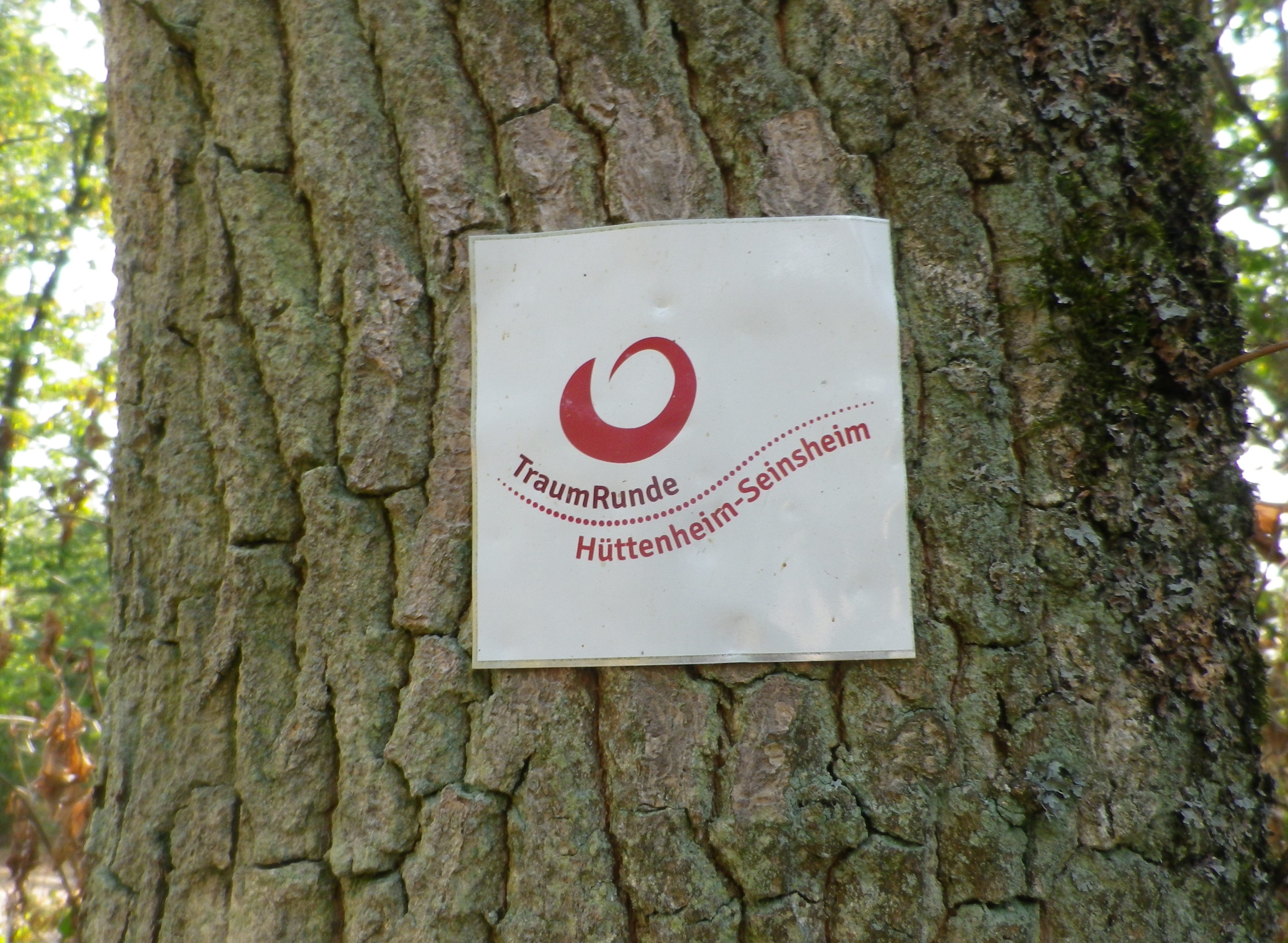
Trail Description:
A meandering circuit, with moderate ascents and descents, as it circles the irregular upper contours of a vine-planted hill on the southwestern edge of the large Steigerwald Nature Park
Trailhead:
Can be anywhere on a circuit, but from a parking perspective, the parking area just below the Weinparadies Scheune is a convenient place to start.
Parking:
Bullenheim: Follow the signs to the Weinparadiesscheune, and before arriving, you will see a small area for hikers’ parking
Public Transportation Options:
Bus: Available to surrounding villages (Bullenheim, Seinsheim, Huettenheim), but not practical
Suggested Stages: (Not applicable)
Trail Itinerary-Reference Points: (Clockwise)
Huettenheim: Jewish Cemetery, Vineyards, two little ponds, forest; Kapellberg overlook, Kunigundenkapelle, scenic overlook, parking lot, Weinparadiesscheune Seinsheim; Steinbruch am Kunigundenwald, picnic area, Tannenberg Kreuz, Wanderhuette am Juedischen Friedhof
Representative Trail Photos:
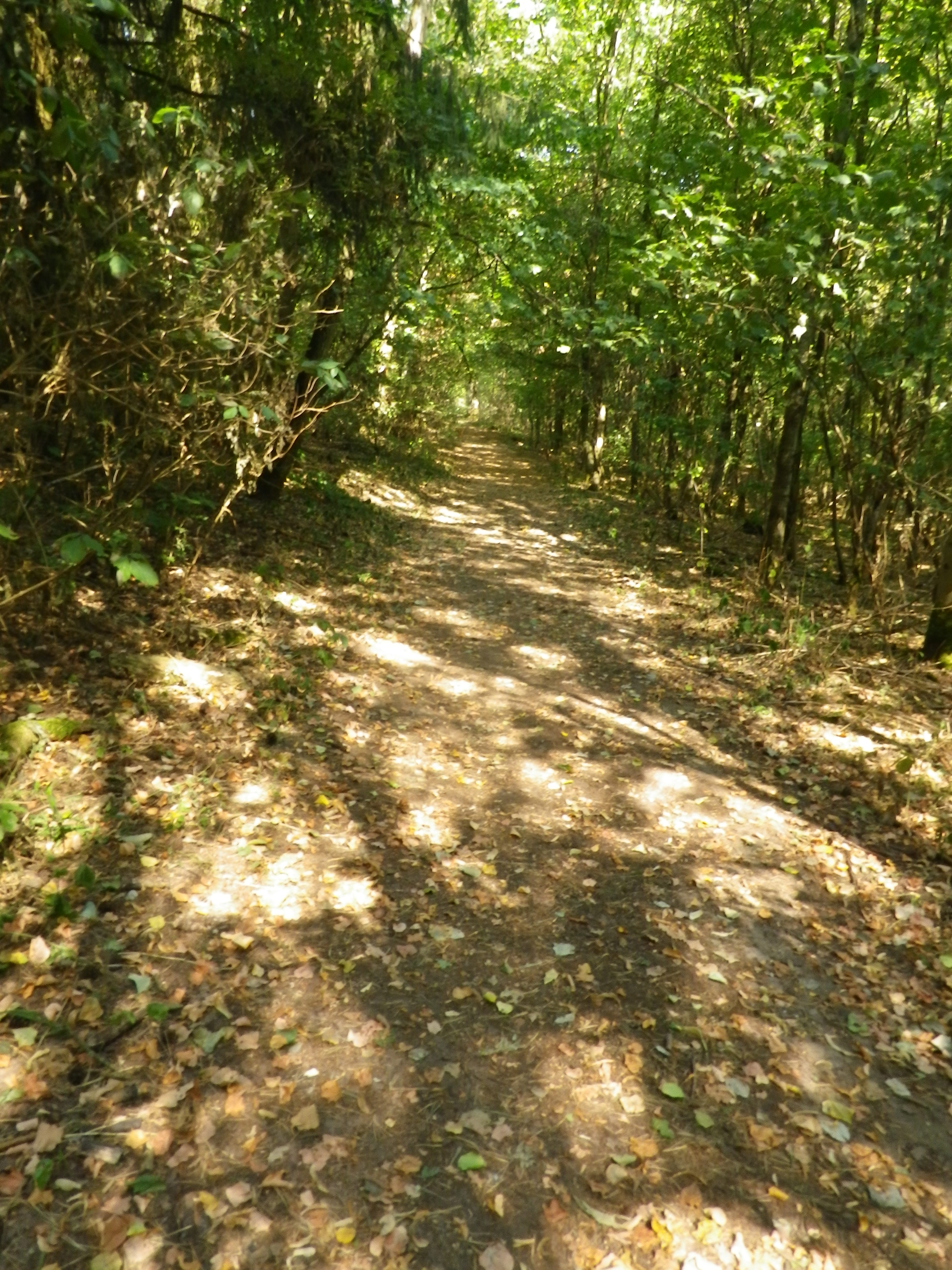
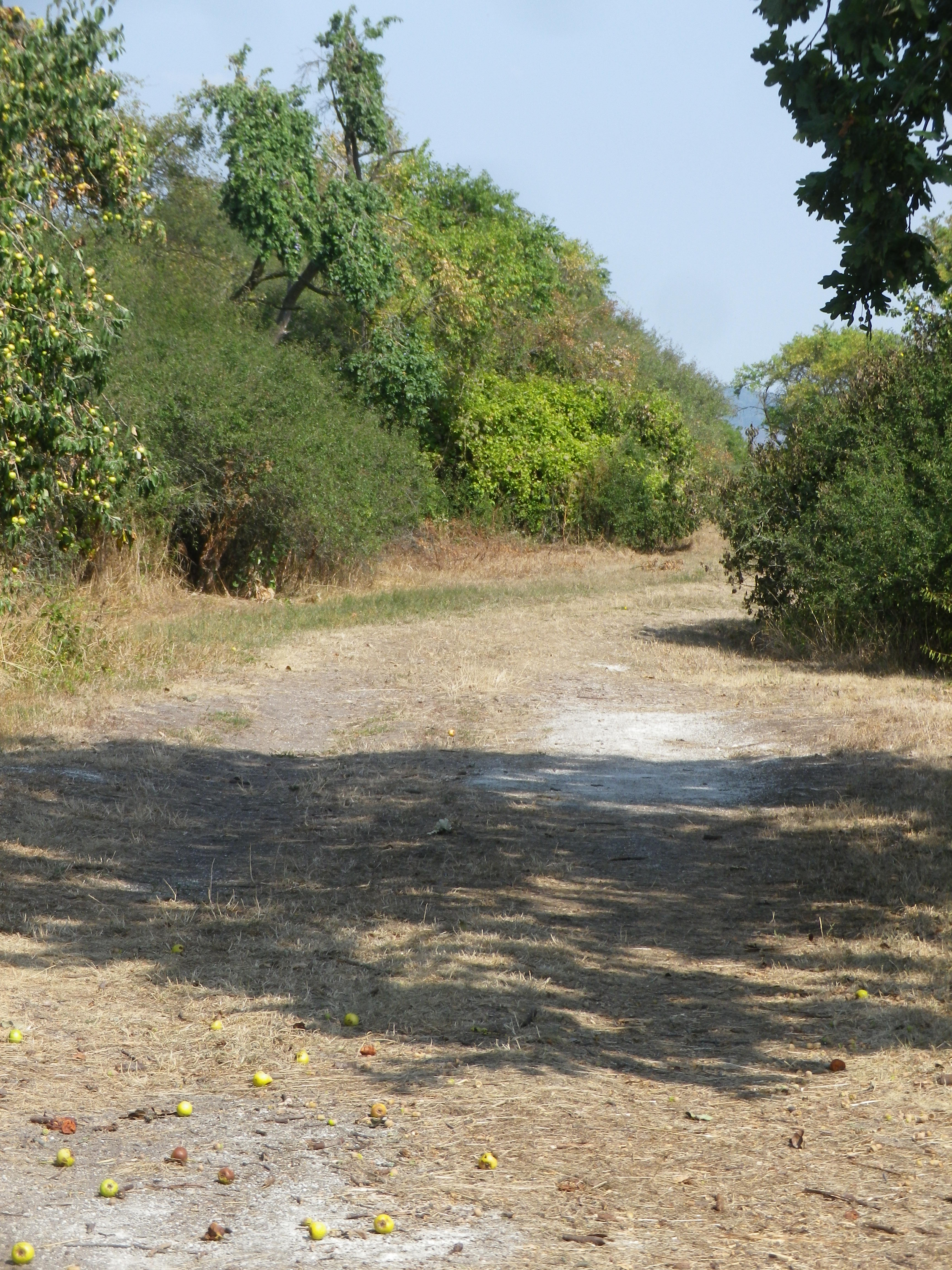
Restrooms:
(Only observed at the WeinparadiesScheune)
Attractions on or near Trail:
Some wine education tables located intermittently along the trail.
Tasting along the Trail:
Weinparadiesscheune Seinsheim, directly on the trail
Small wineries and taverns in Bullenheim, Seinsheim and Huettenheim, all slightly off the trail
Alternative Options:
Hiking: TCW 49: Durch Fraenkische Weinparadies: a 12.9 kilometer circuit, through much of the same area, but, more challenging ascents and descents, and about 2 miles longer. See https://www.outdooractive.com/de/route/wanderung/steigerwald/tcw-49-durchs-fraenkische-weinparadies/227470702/
Additional Information:
Regional: https://www.ippesheim.de/
Trail specific: https://www.outdooractive.com/de/route/wanderung/fraenkisches-weinland/traumrunde-huettenheim-seinsheim/9552201/#dm=1
Comments:
Few parking lots, per se, just parking on the edges of lanes. So please be conscientious and respectful when parking road-side in the villages or vineyards.
Gallery August 2023
Through Crus and Clos
Passing through vineyards in the Haut- Rhin department in Alsace is always delightful, especially when passing through some Grands Crus vineyards. This trail also ran by, not through, other vineyards known as clos. By definition, clos are vineyards enclosed by walls. They are special places, like the Grands Crus, each with a special pedigree, producing sought-after wines.
This circuit trail began in Rouffach, a town I had never visited. I would visit the compact historical center after my ride, tucked away from the modern main roads (D18Bis), wishing I had more time to spend there! Then again, time there would have meant taking time from some of the other equally delightful towns and villages (Hattstatt, Obermorschwihr, Eguisheim, Voegtlinshoffen, Gueberschwihr and Pfaffenheim) along the route.
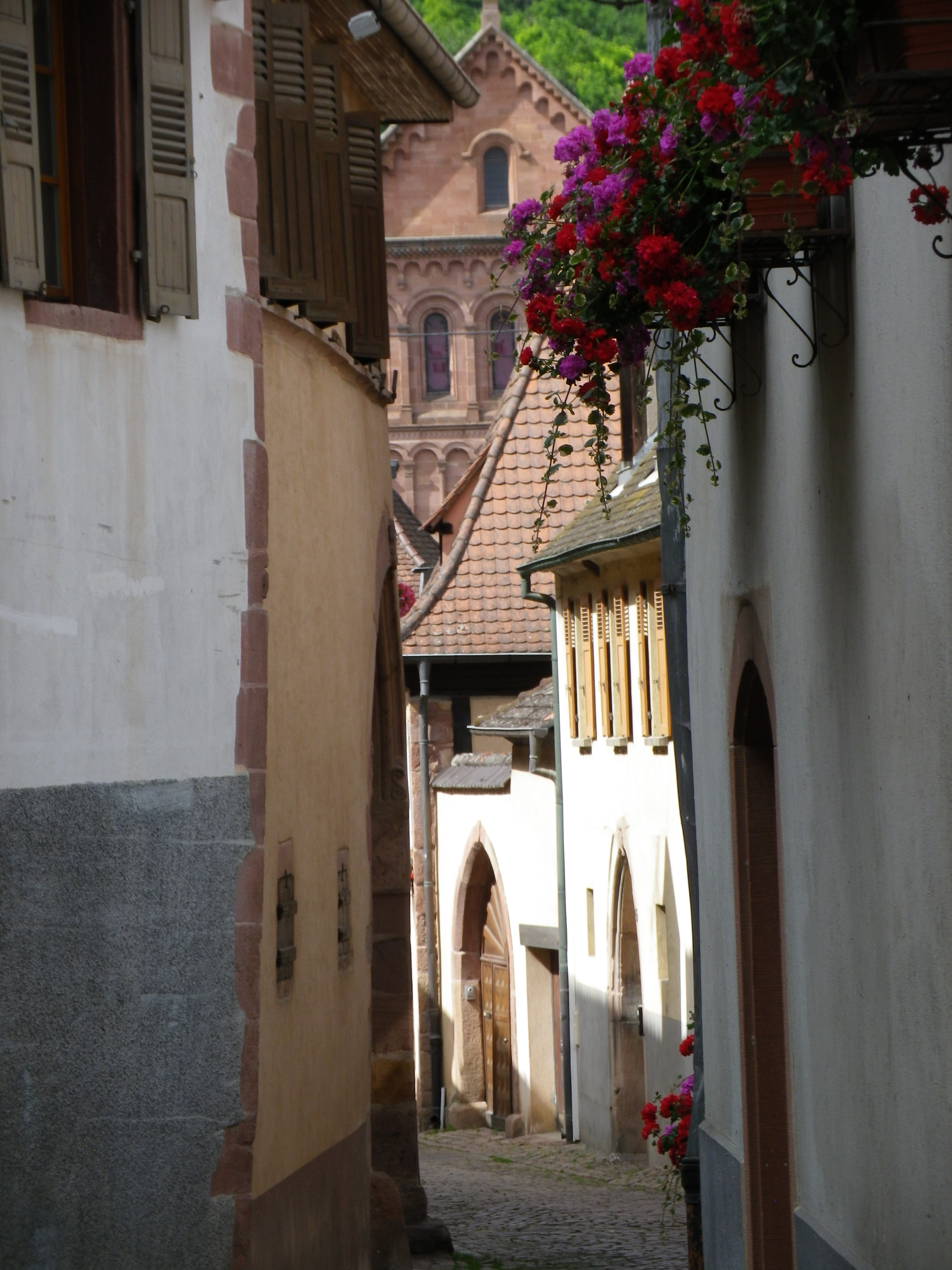
But this circuit was also about the well-respected vineyards in this sector of the Alsace wine region. No sooner through the built-up area of Rouffach, Clos de St Landelin comes into view. Like many clos or Grands Crus, this one also spelled out its name in large letters, another mark of distinction for these special vineyards. Named after an itinerant Irish monk, Clos de St Landelin lies within the Grand Cru of Vorbourg, overlooking Rouffach. I would see this combination of Grand Cru and Clos again, further north, where the Goldert Grand Cru has the Clos de St Imer within it.
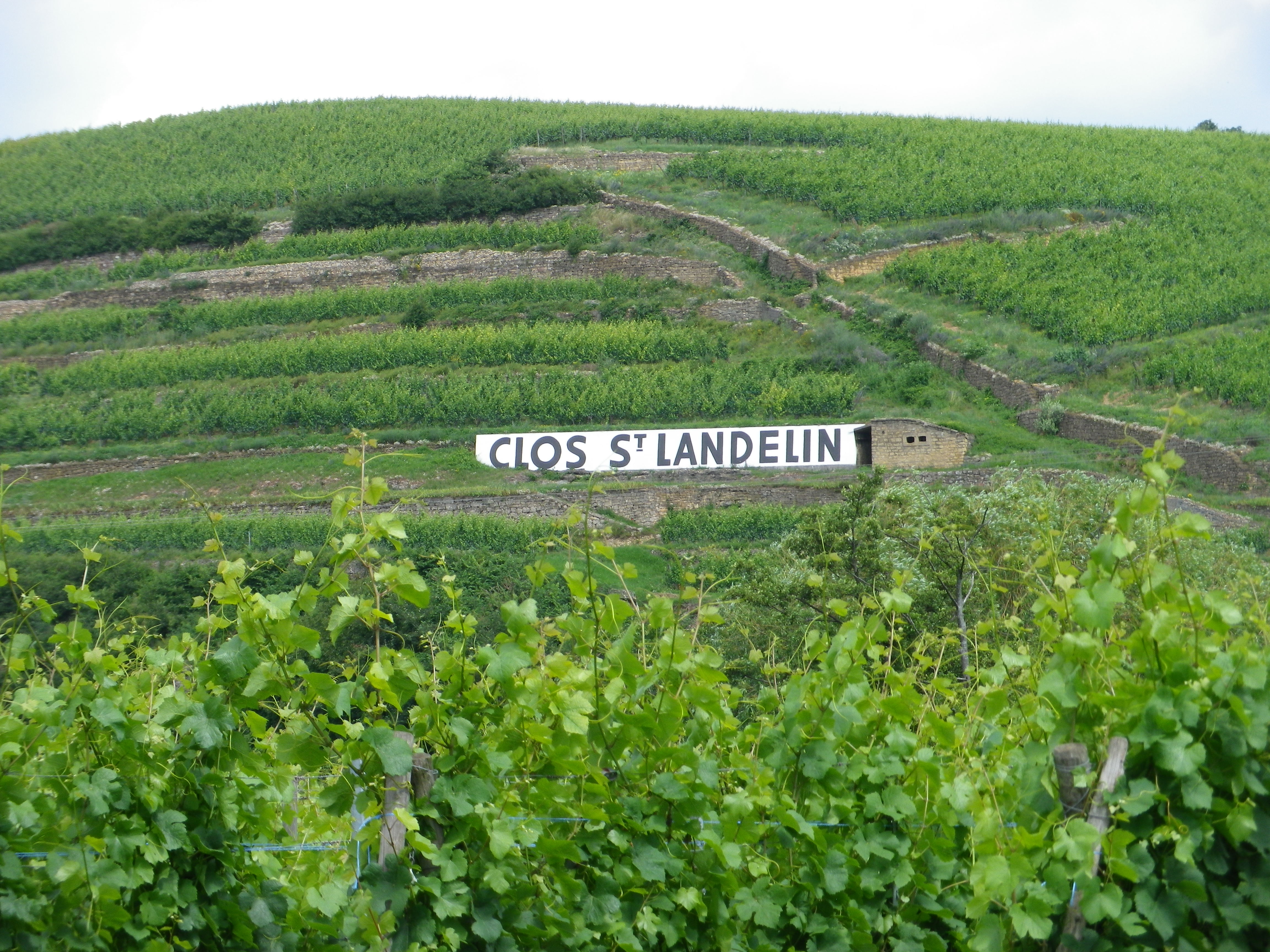
The reason for this is simple. Merovingian kings allotted early monks large territories in pagan areas to encourage conversion, as well as to grow vines (for communion wine). Both vines and conversion went from strength to strength, and soon Alsace was known for both. The circuit took me past both the former Abbey of Marbach, (over 1000 years old), and the nearby Hatschbourg Grand Cru. We have the monks to thank for the rebirth of wine -making in Alsace, and their descendants for doing such a great job of it.
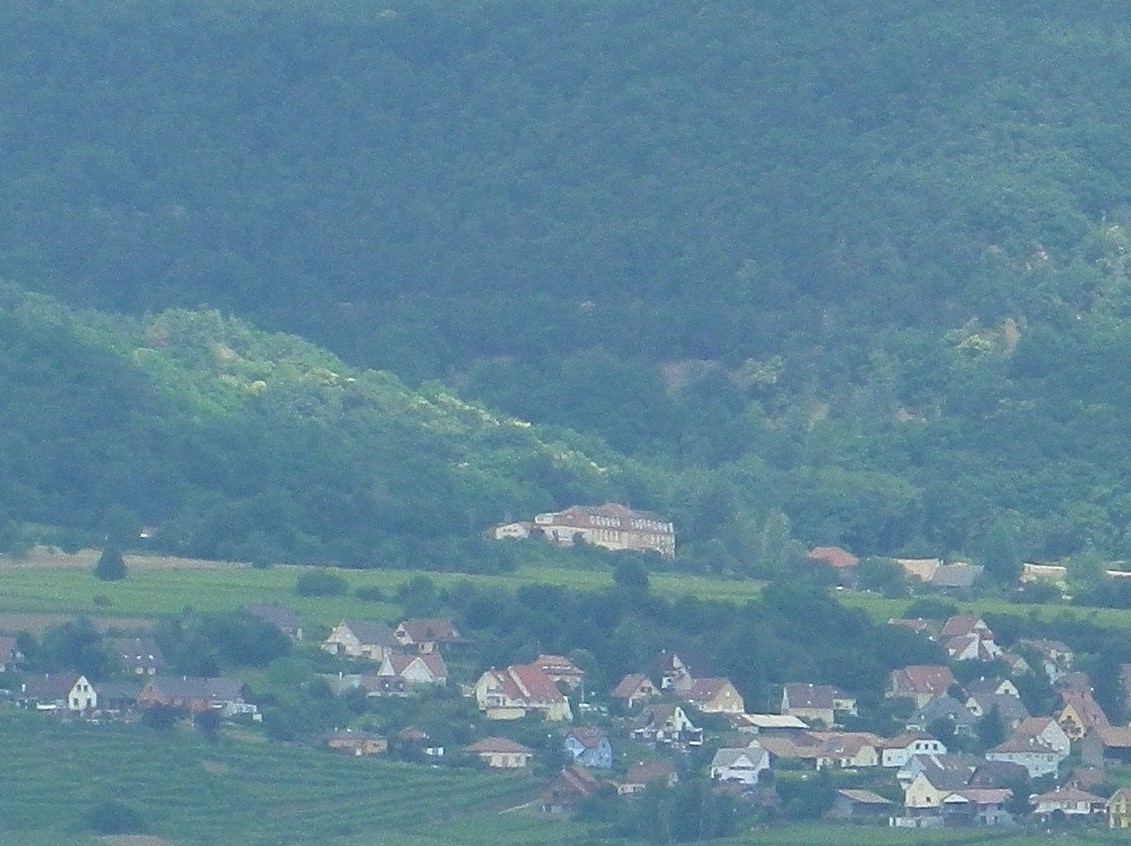
But the height of this match-up came in Eguisheim, at the end of the early Middle Ages. This village which still retains its medieval look, saw a local man, Bruno von Egisheim-Dagsburg, become Pope Leo IX. As son of a nobleman, I wondered, if as a child, he lived in one of the three castles high above the town. (To hike there, see the Nutshell here.) Neither the palace in the center of the village, nor the Chapel of St Leo IX, dates to his era. Nonetheless, the narrow, twisted alleyways, and colorful half-timbered cottages make this a very photogenic village to visit. (Conveniently, Eguisheim marks roughly the half-way point on the circuit, and is the site of a Wolfberger wine cellar – and I love their Cremant!)
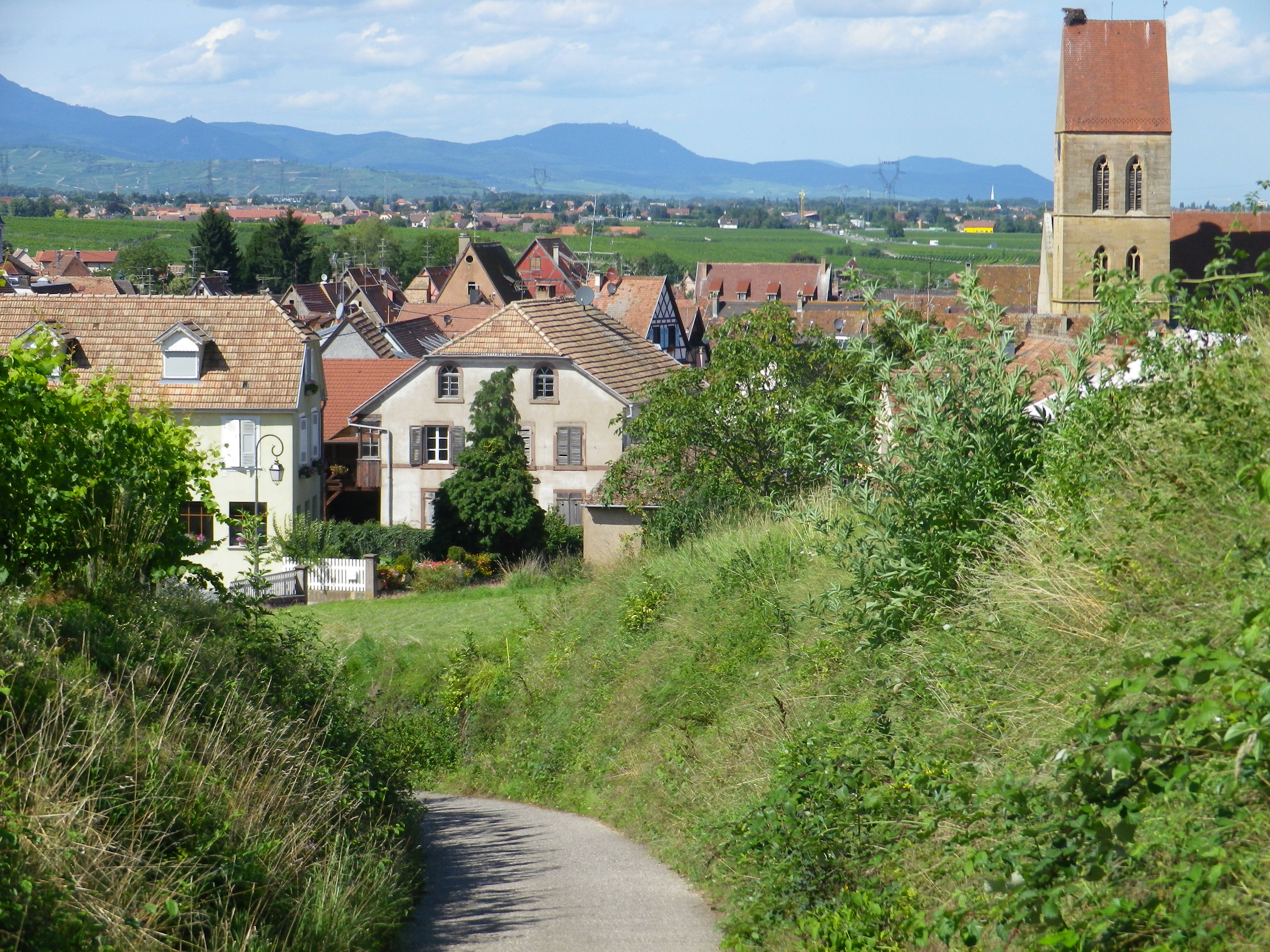
Leaving Eguisheim, up a short but rather steep path (maybe too much Cremant?), I found myself in the middle of the Eichberg Grand Cru. Monks owned this one too, at one point. Shortly after, I was cycling through the Hatschbourg then the Goldert Grands Crus, cruising into Gueberschwihr in no time. This attractive village is home to the Ernest Burn winery. The current owner, whose family’s wine-making tradition dates to 1620, showed me around, and offered more tastes of his Grand Cru Goldert and Clos St Imer wines than I was good for me, at that point. But they were distinctively perfumed and lovely to taste.
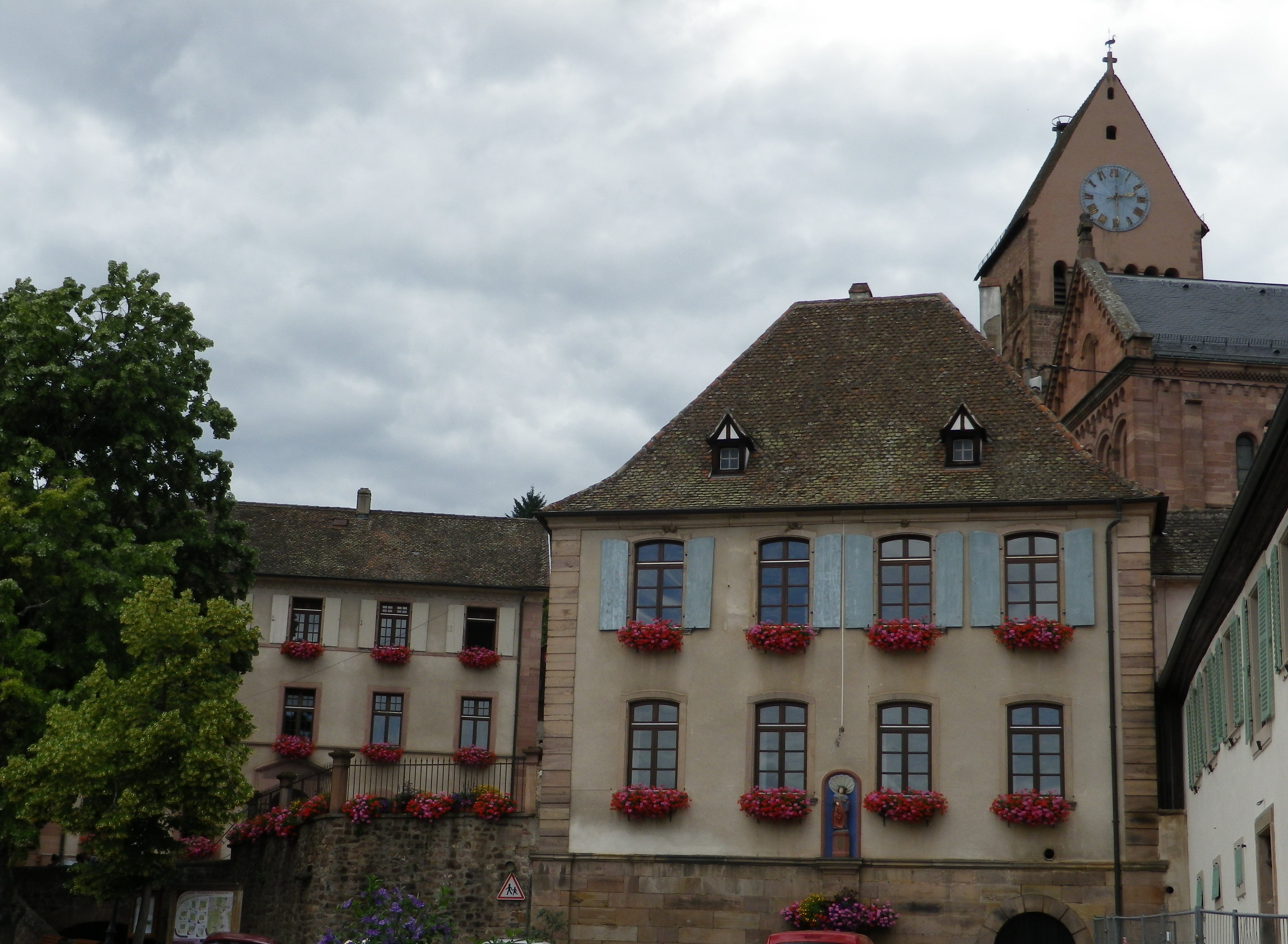
Fortunately, to return to Rouffach, there were only about five kilometers (3.25 miles) to go. With the beautiful weather and views, and having combined the best of both the cultural and viticultural worlds, I found this a really enjoyable, and quite memorable, half-day ride that I was sorry to finish.
